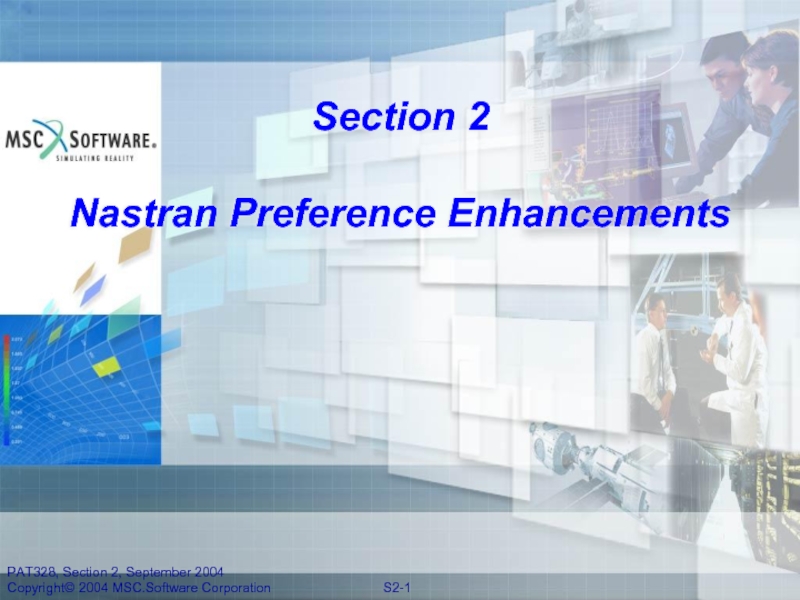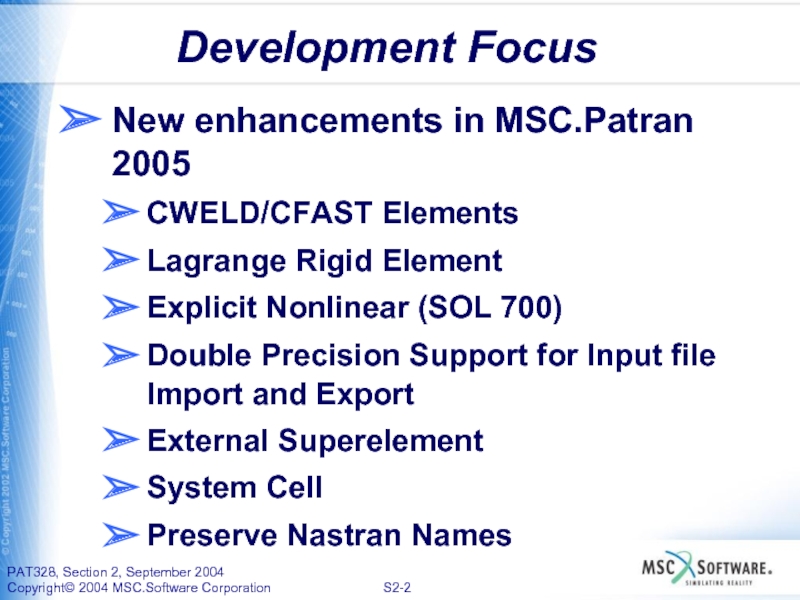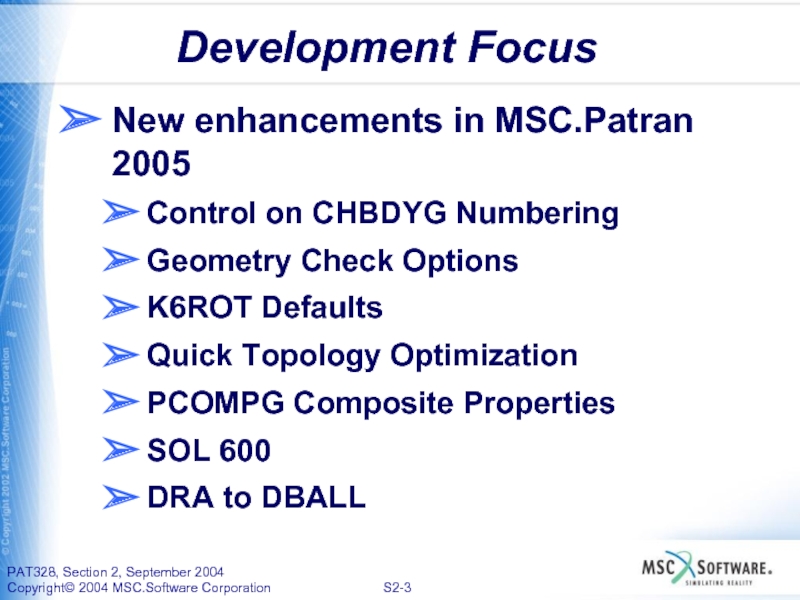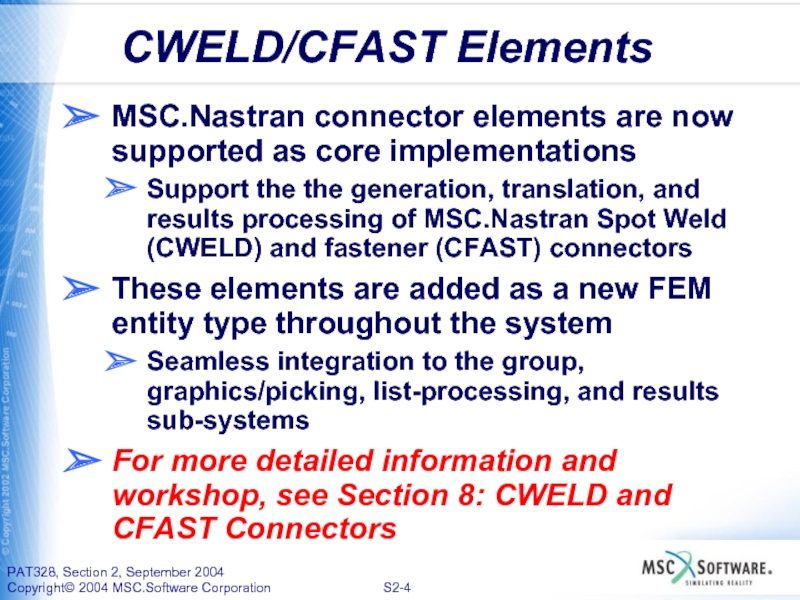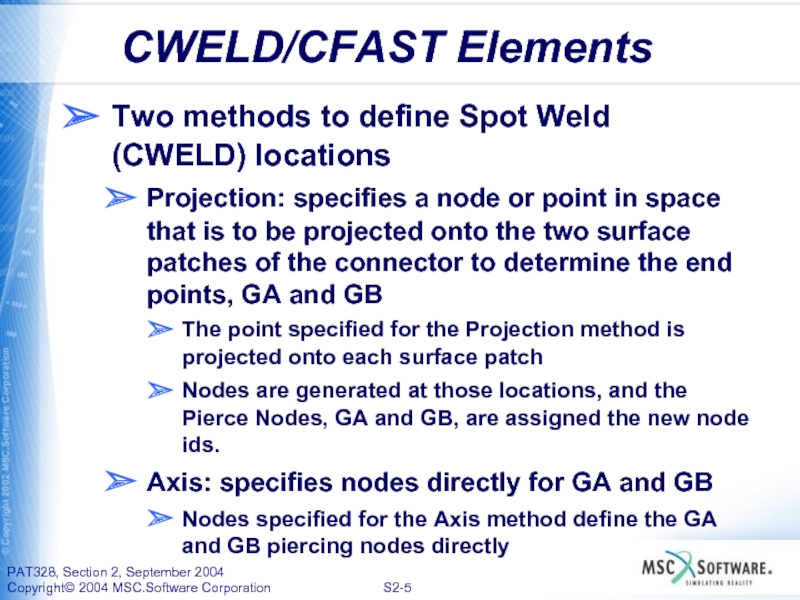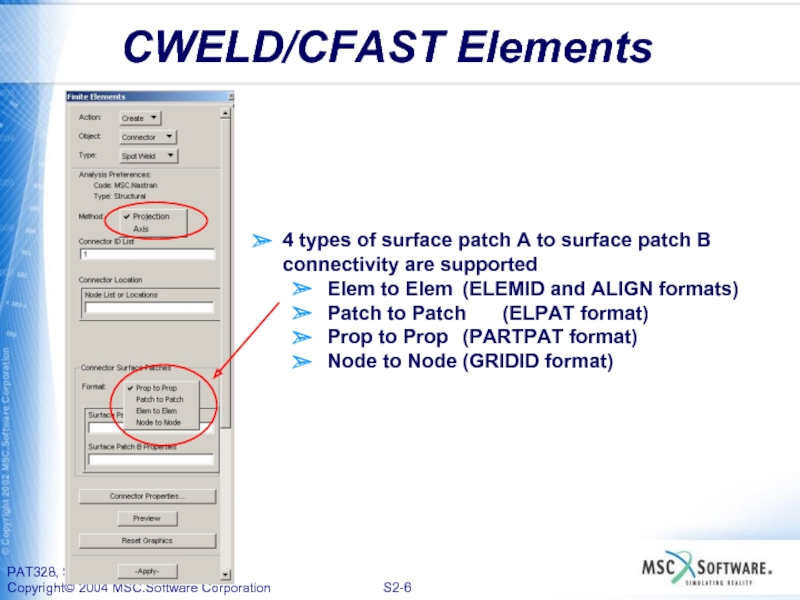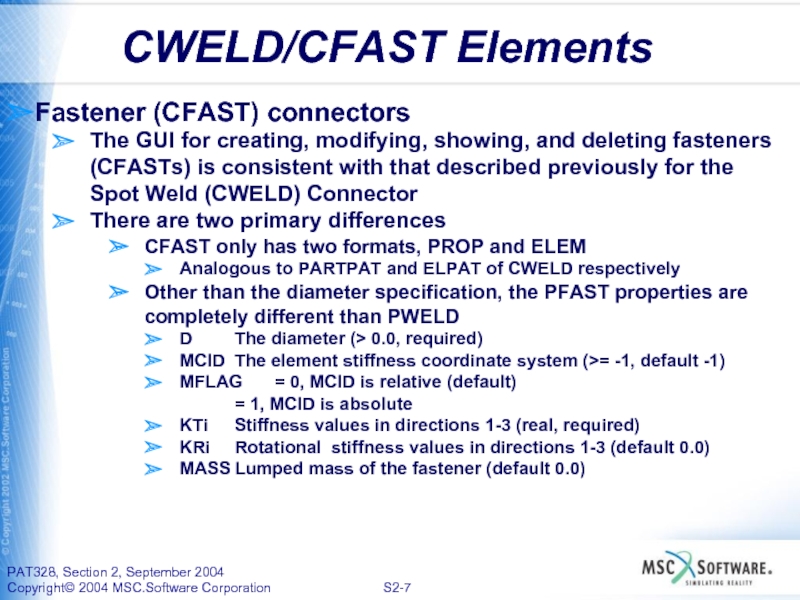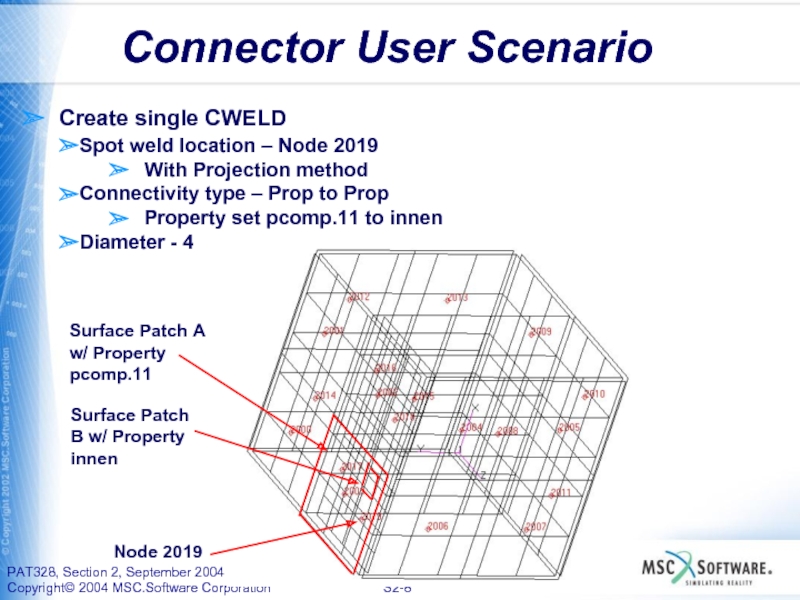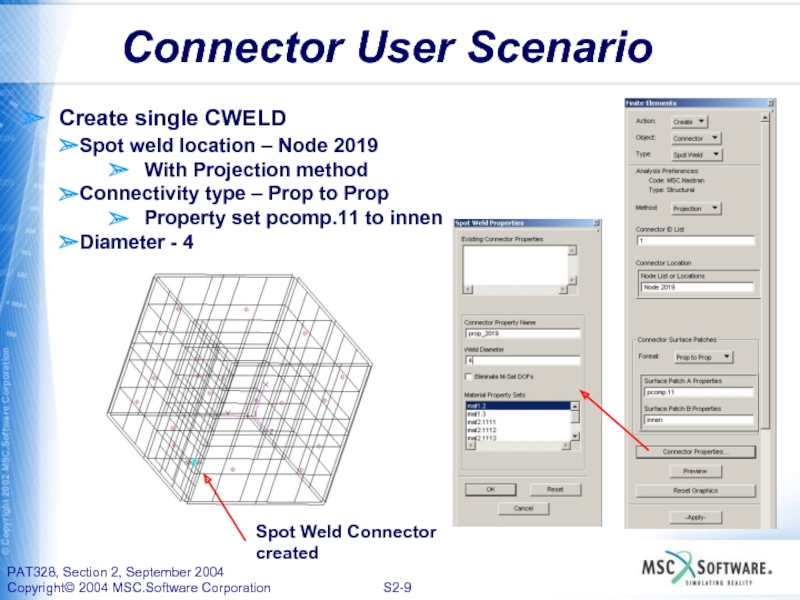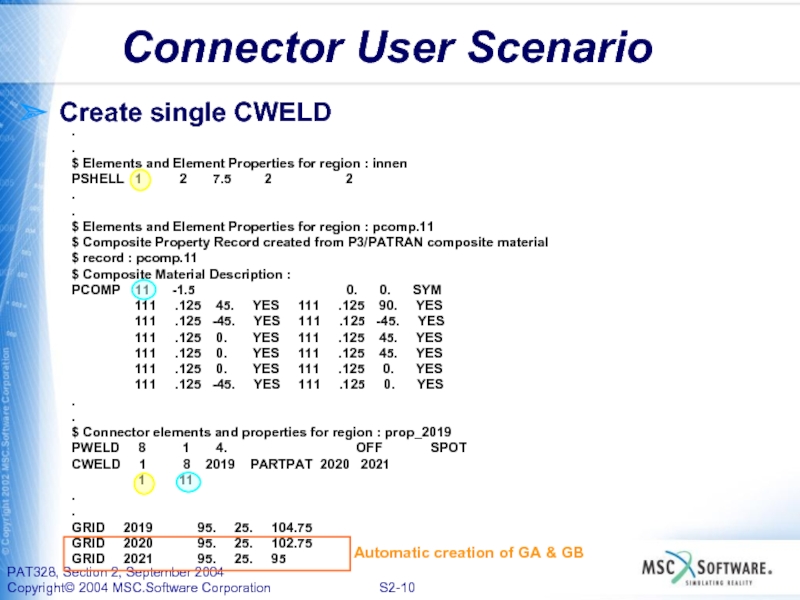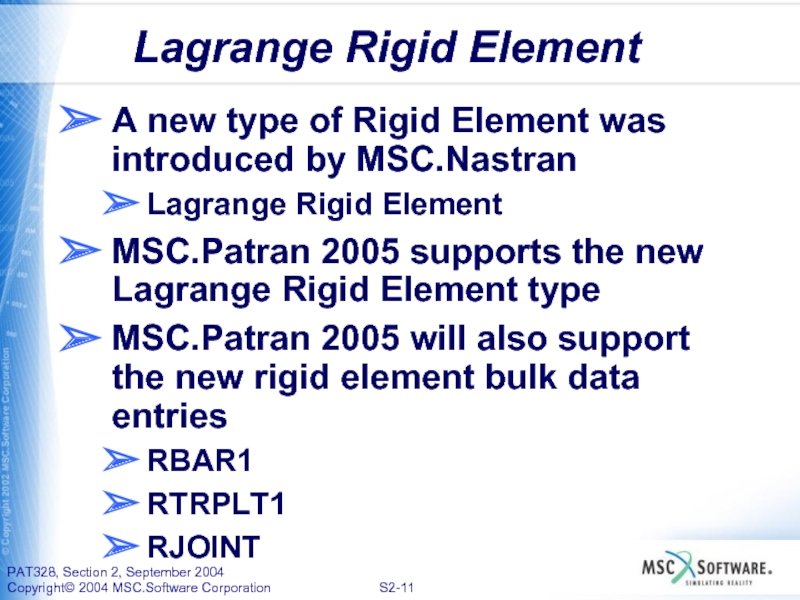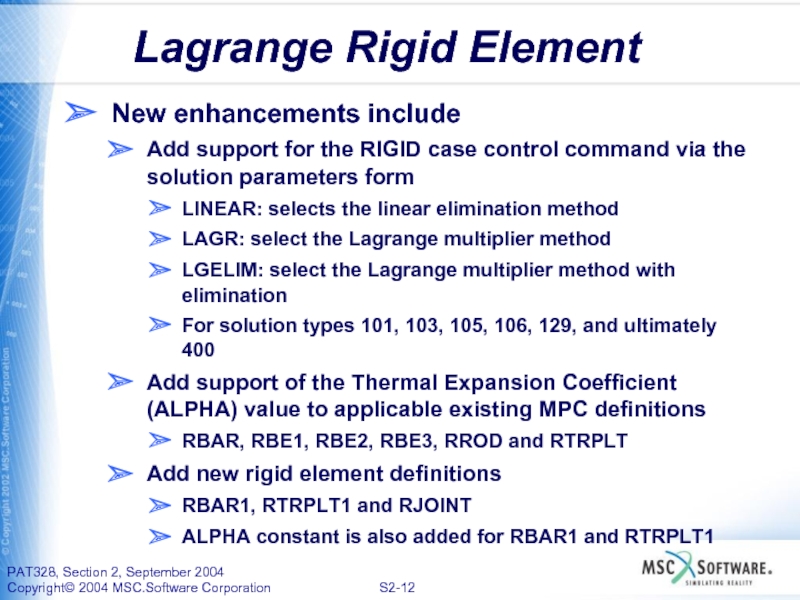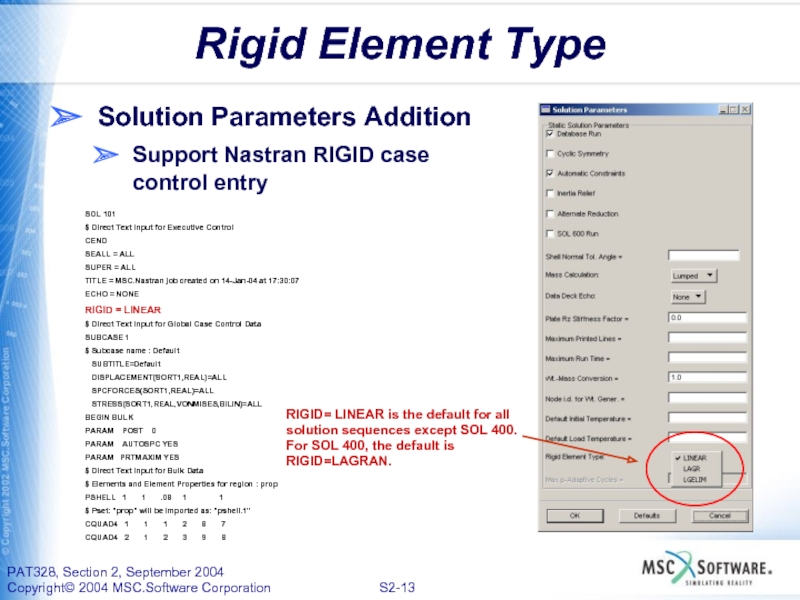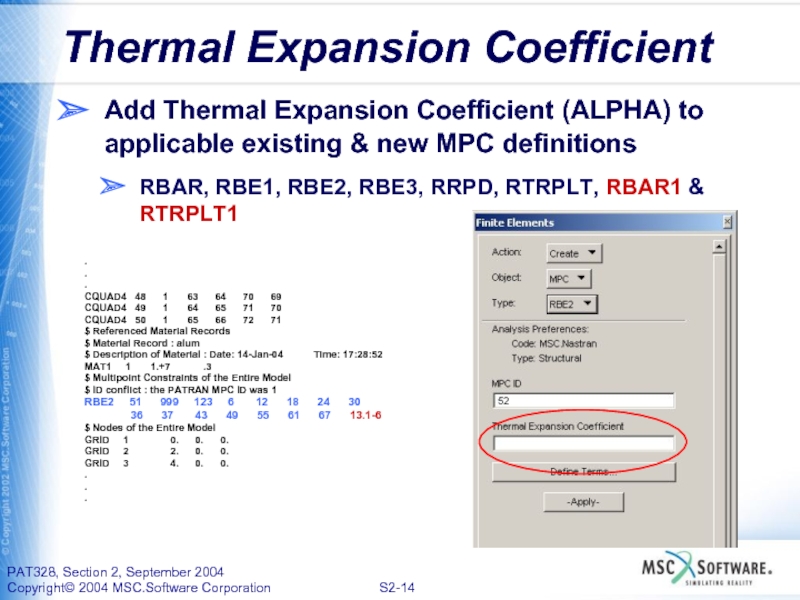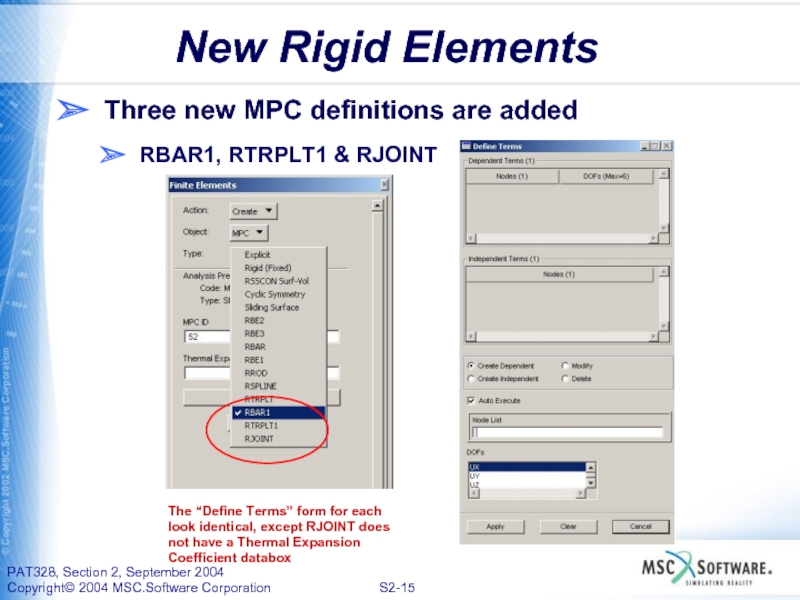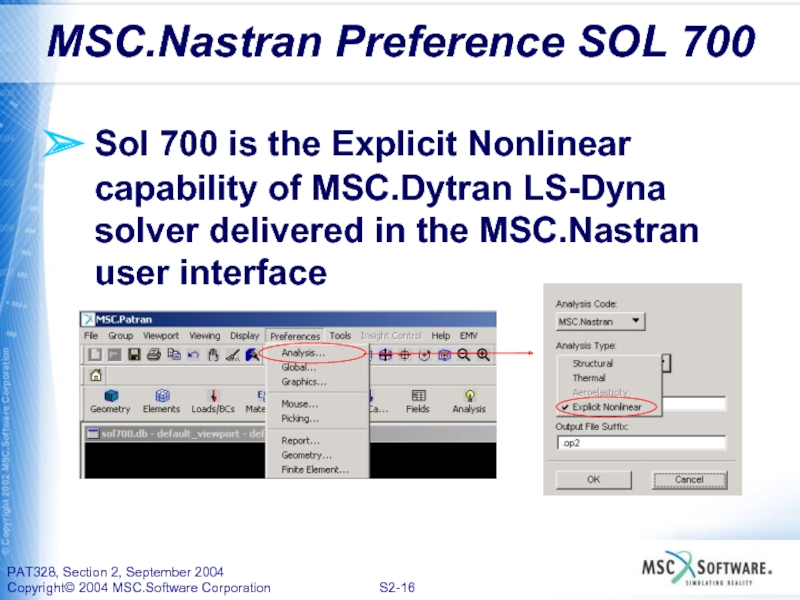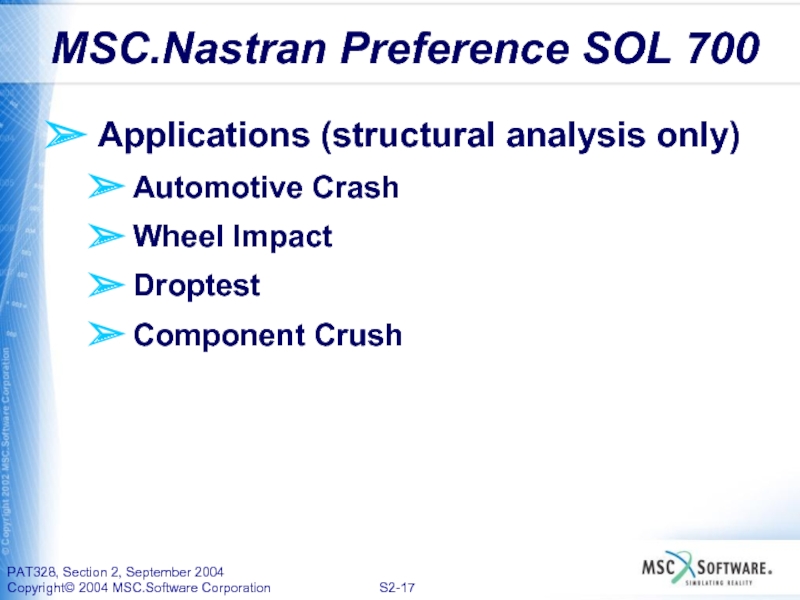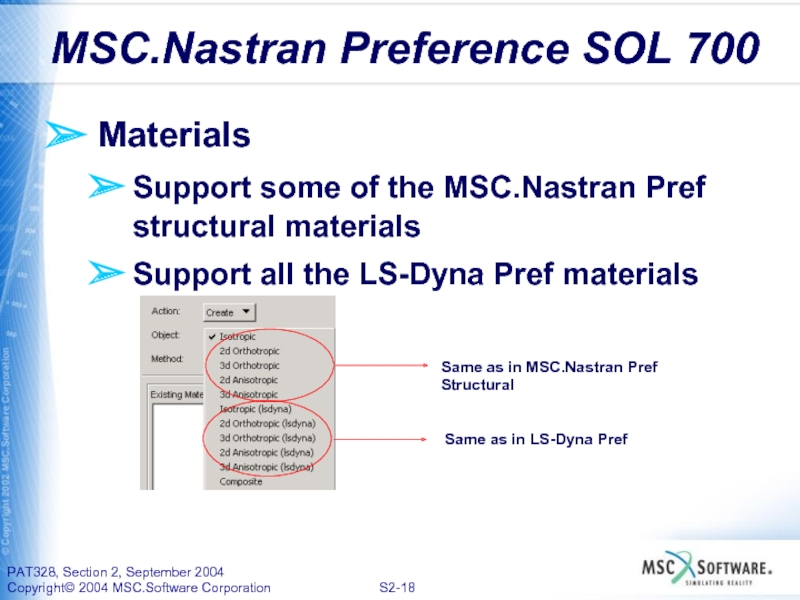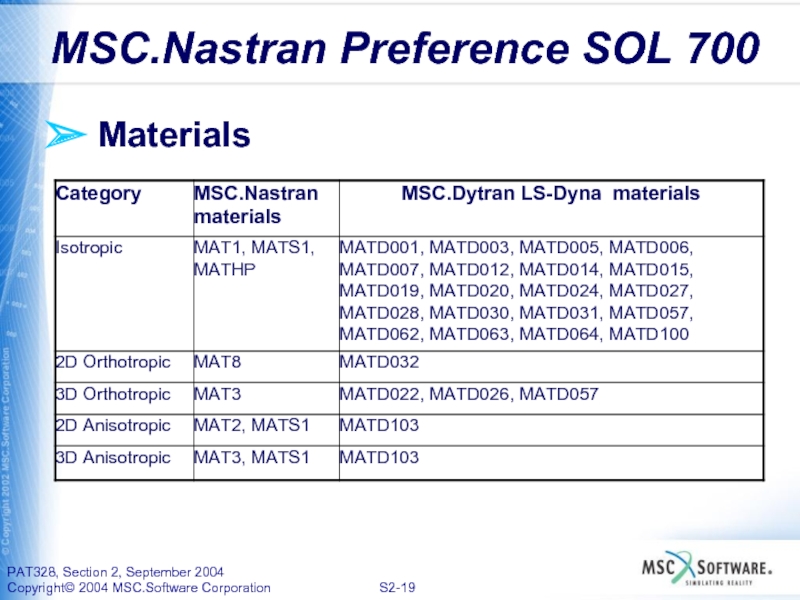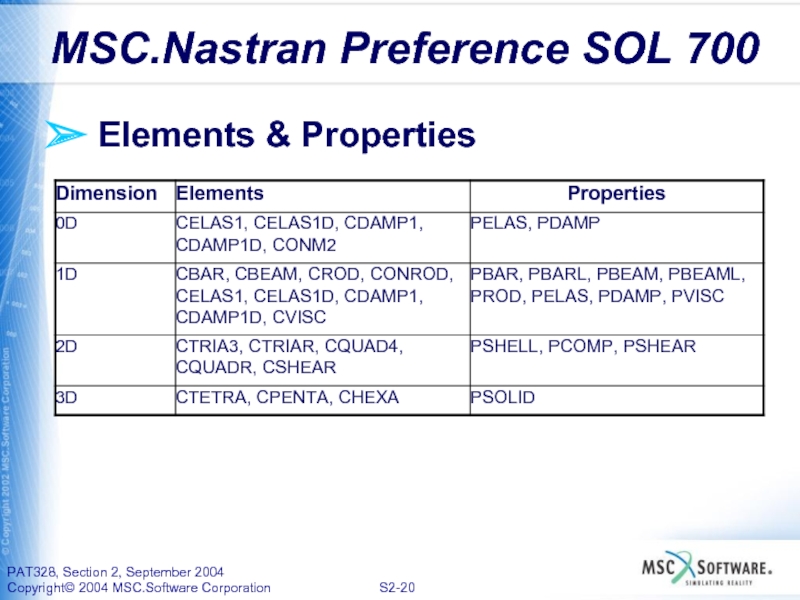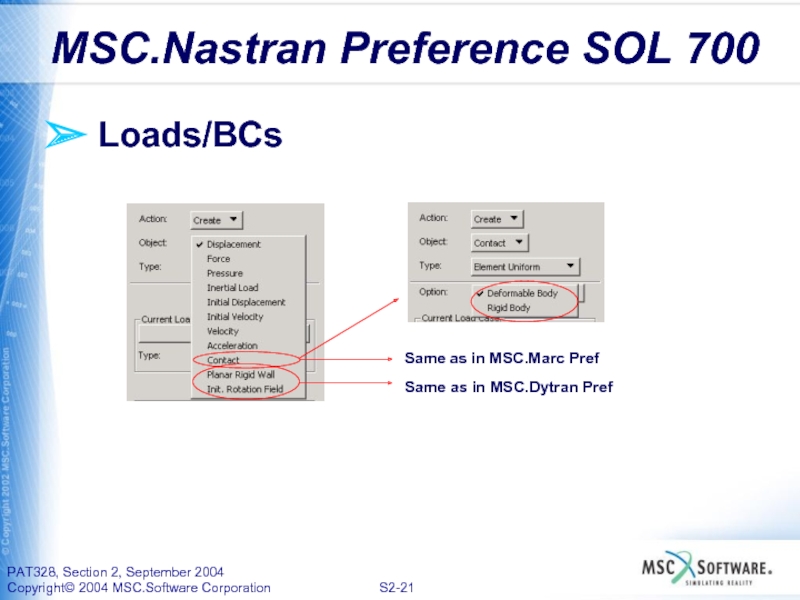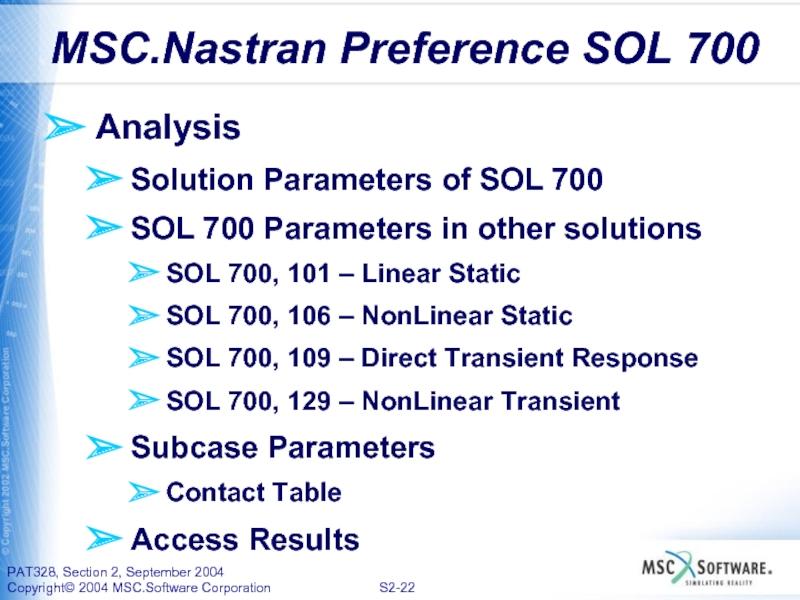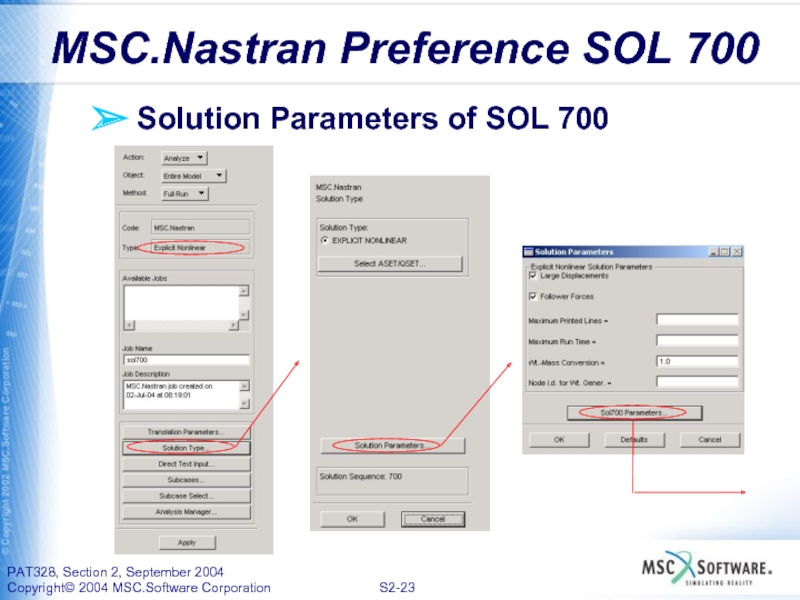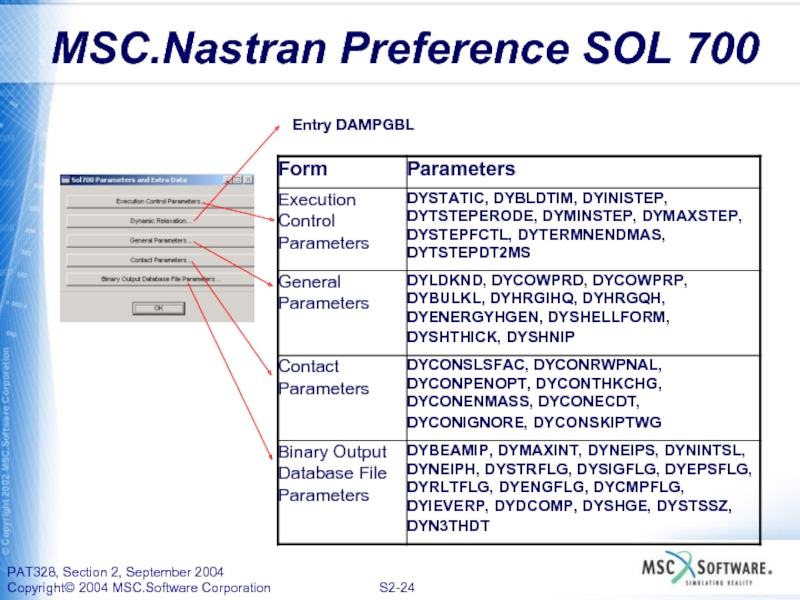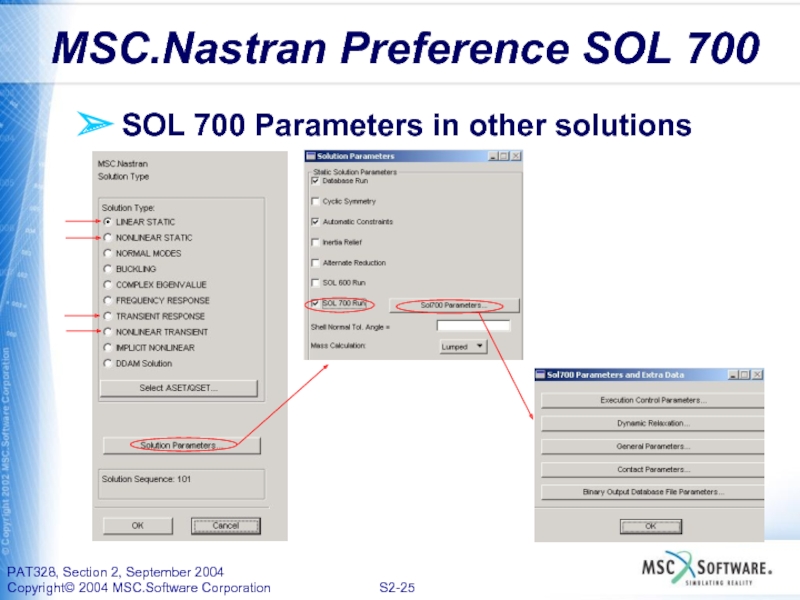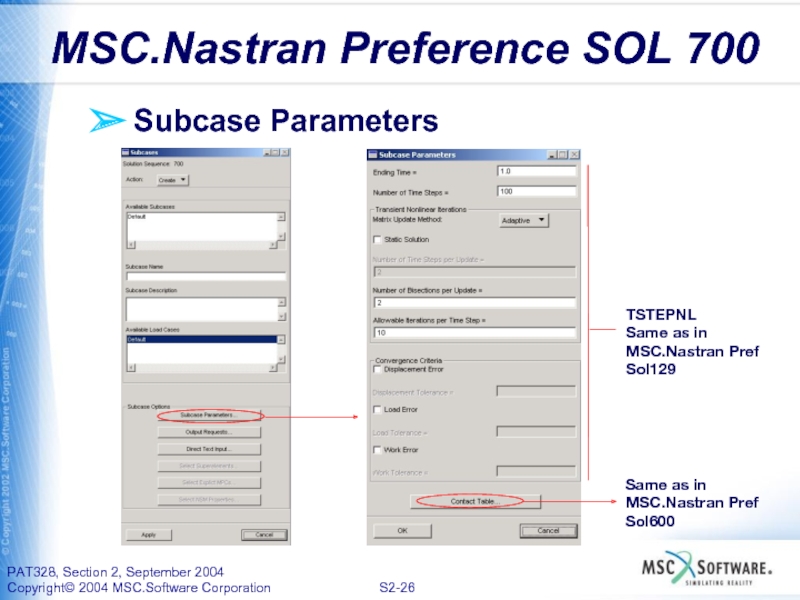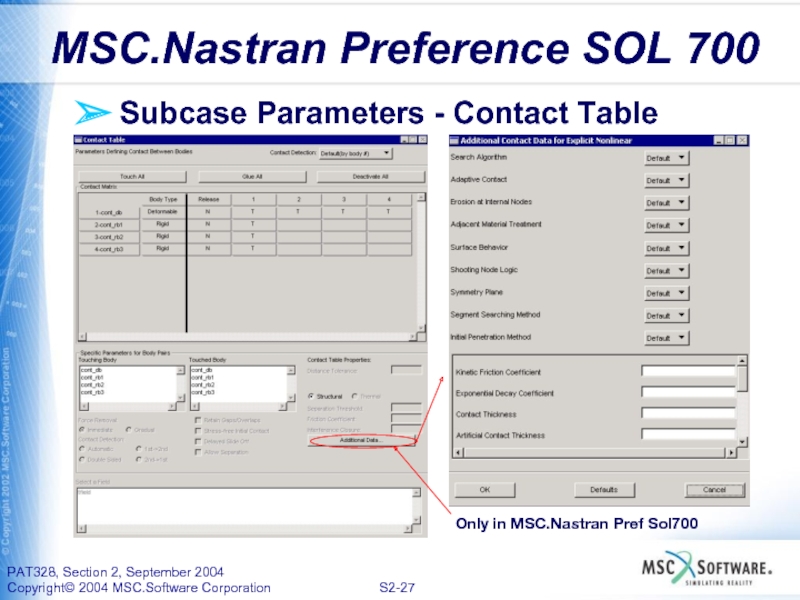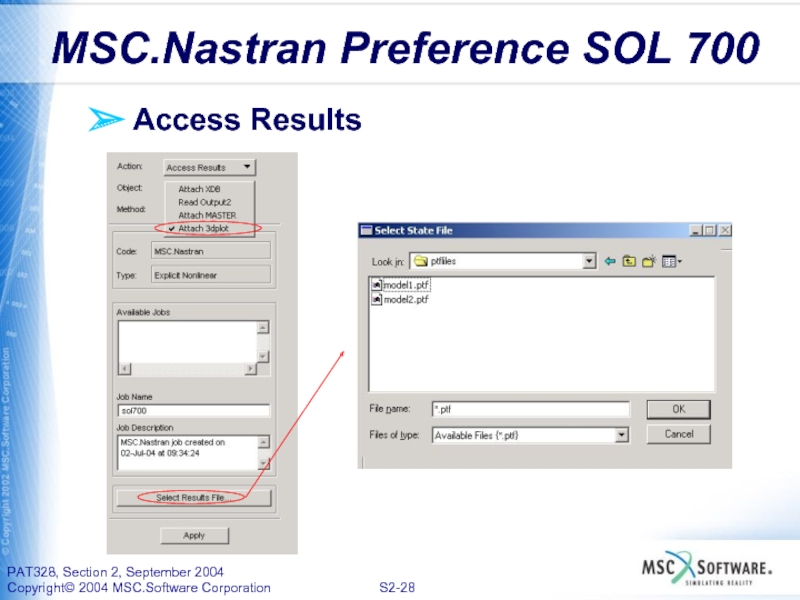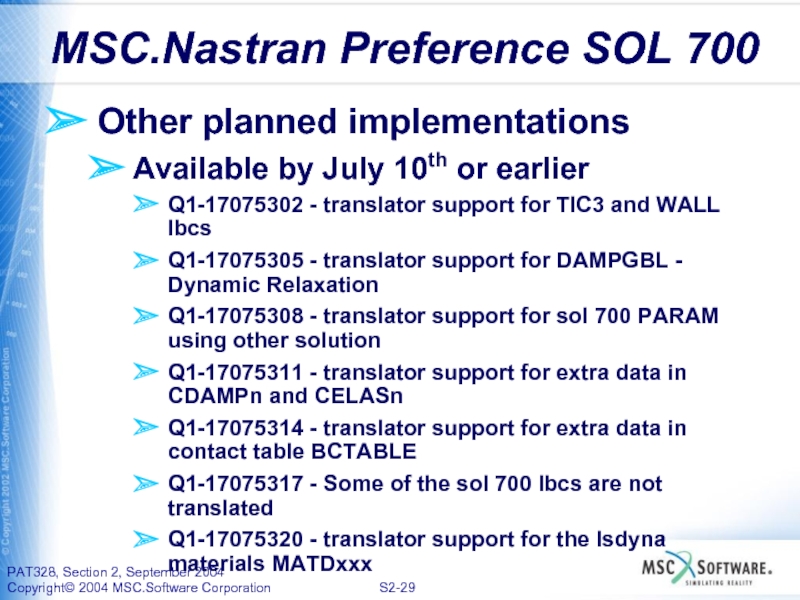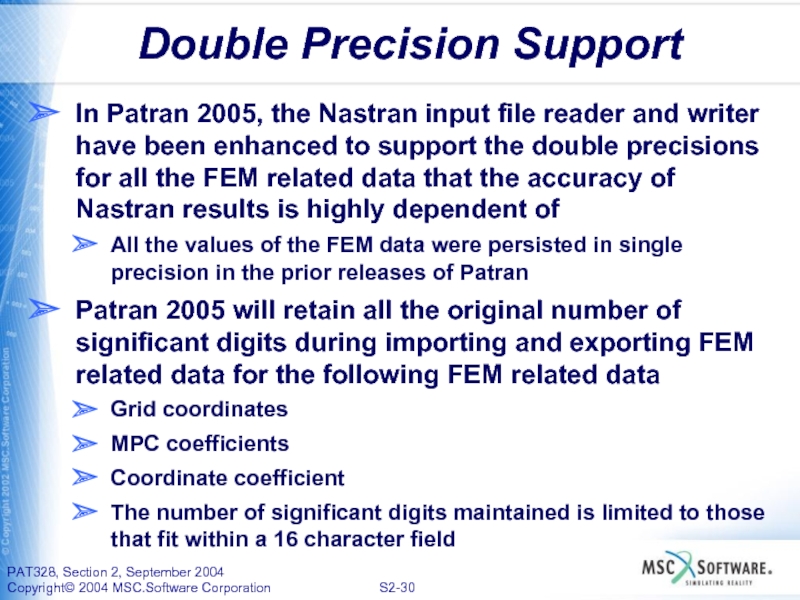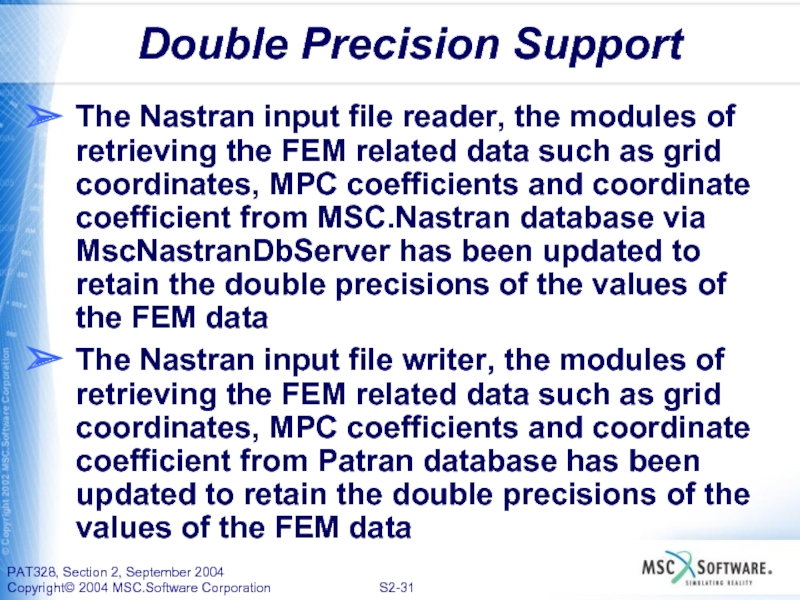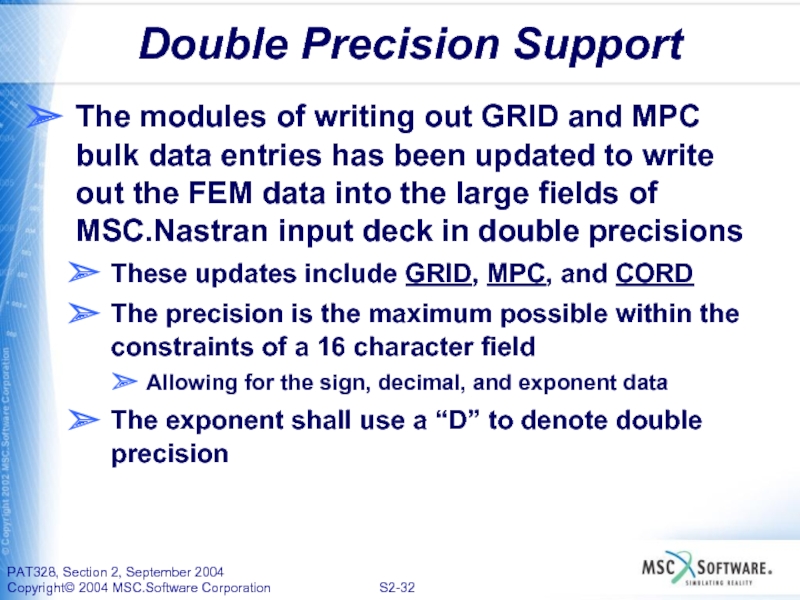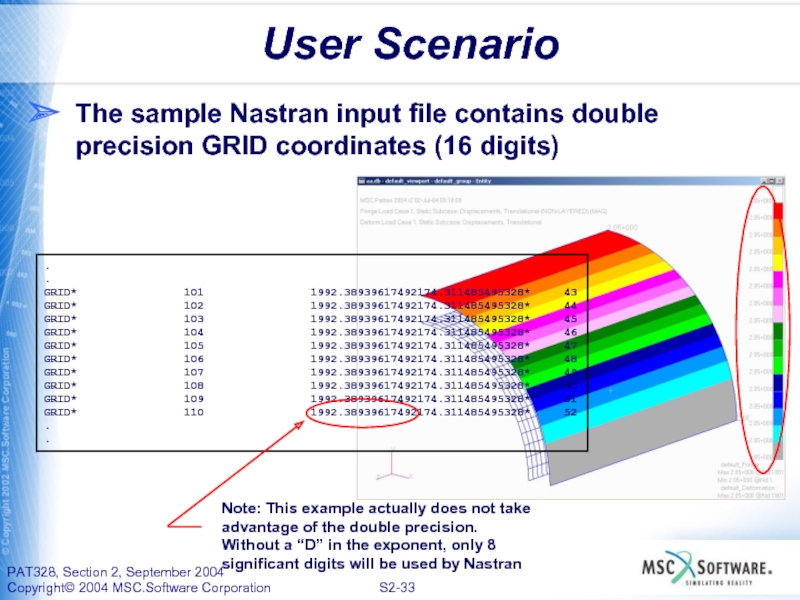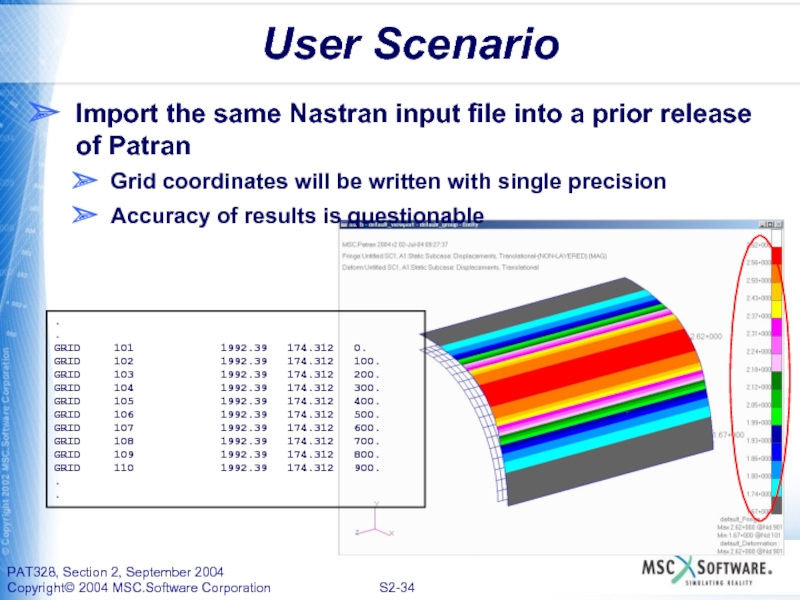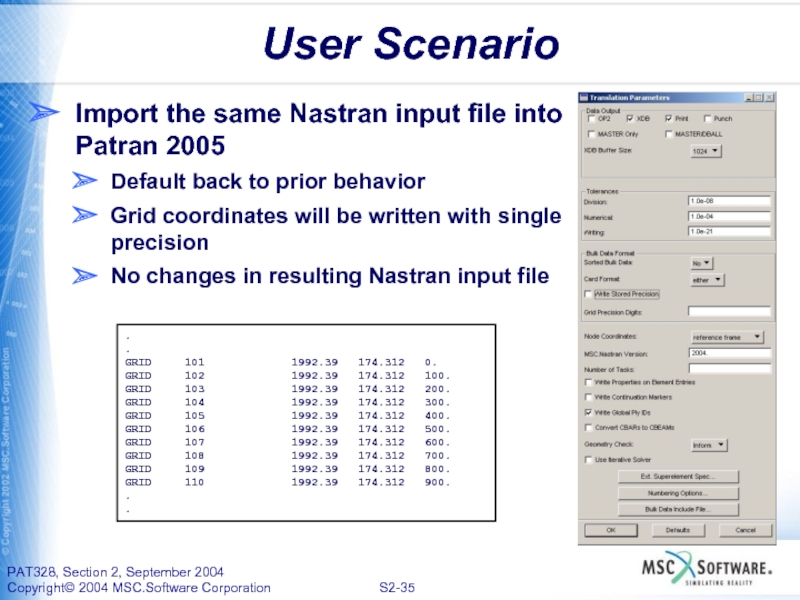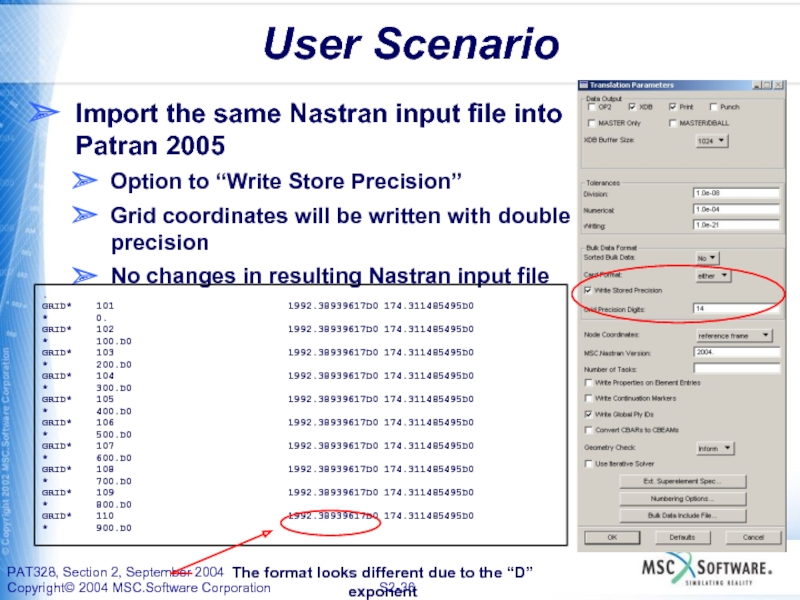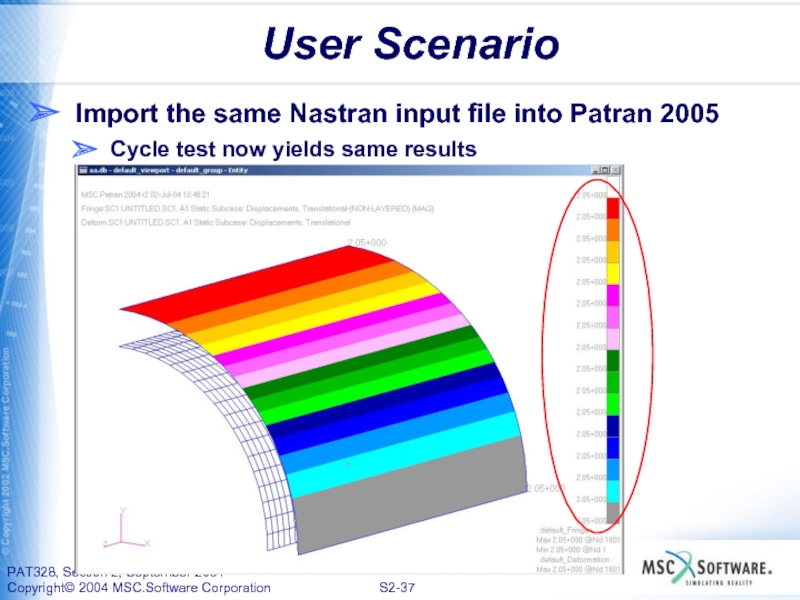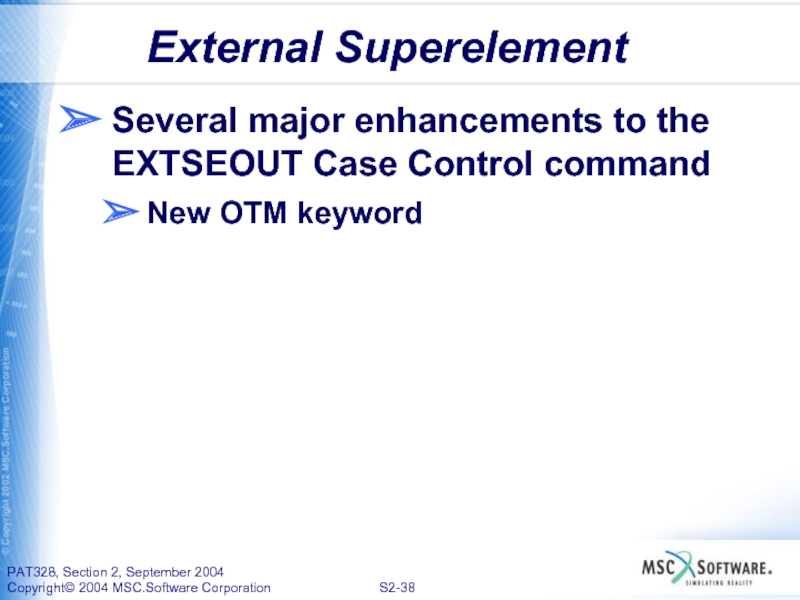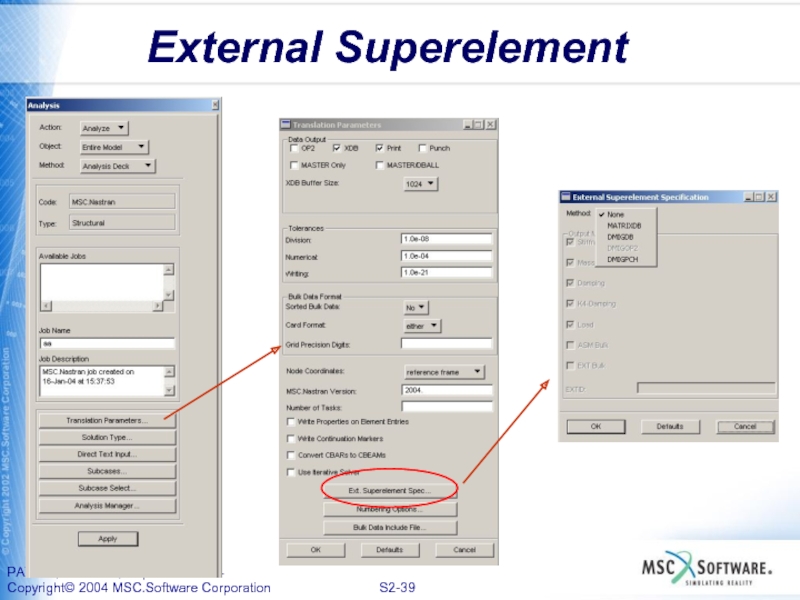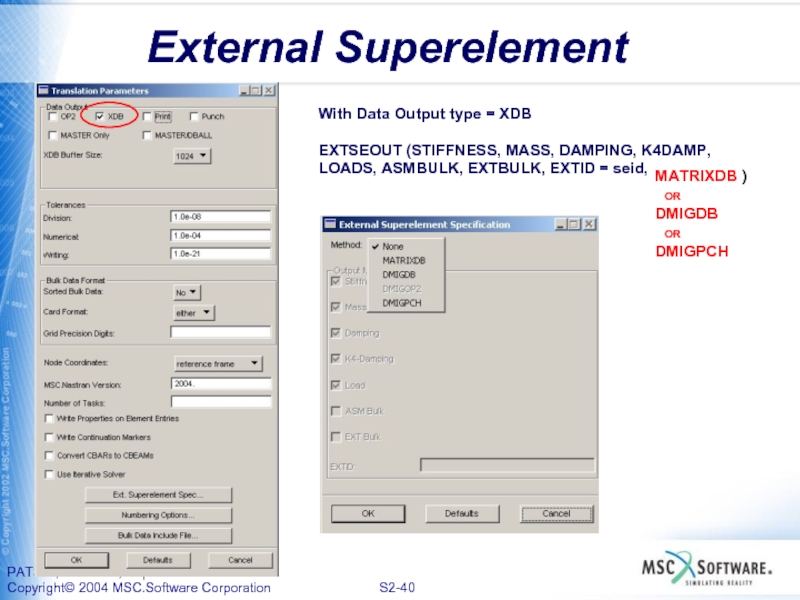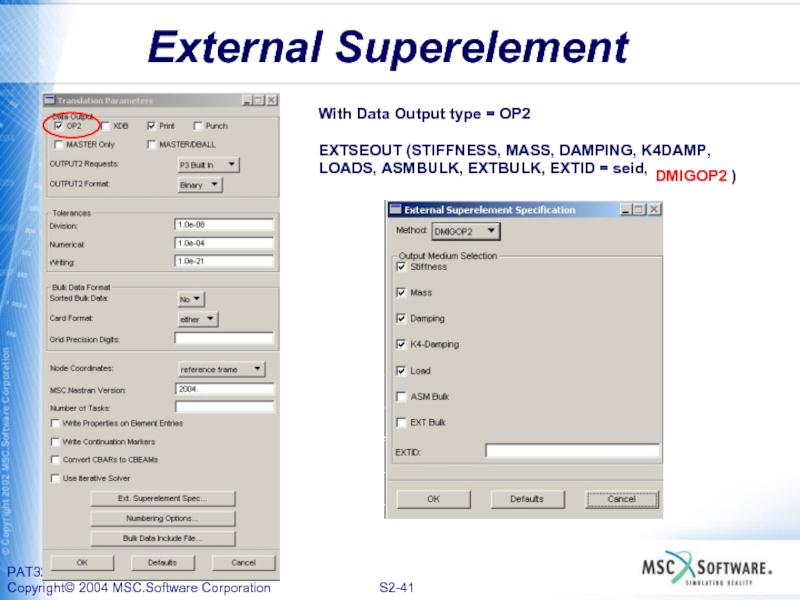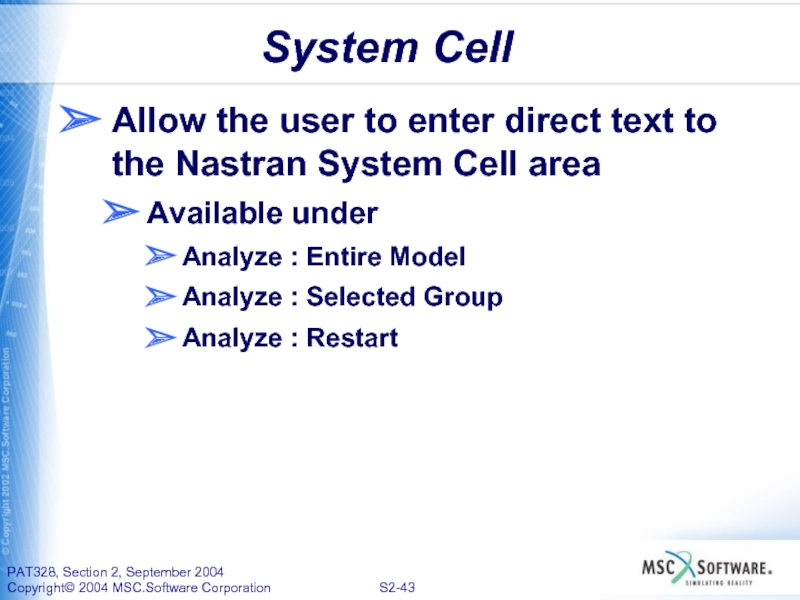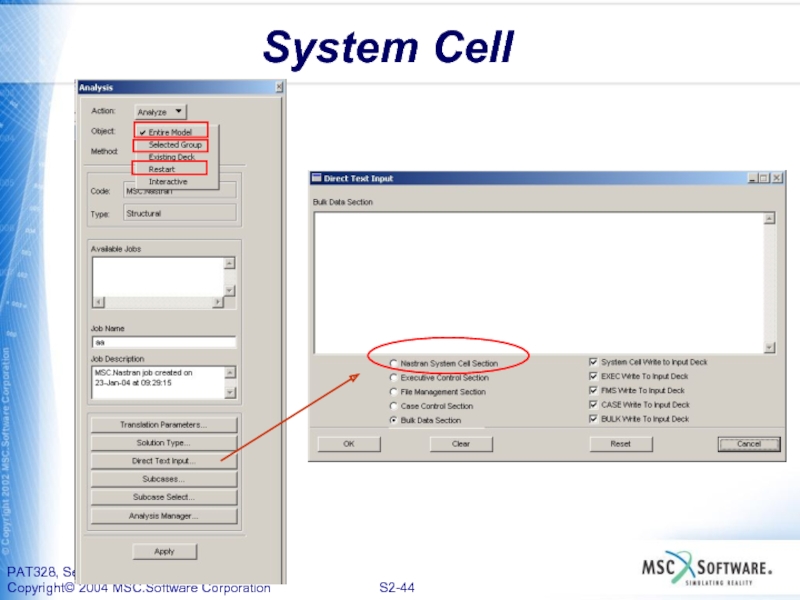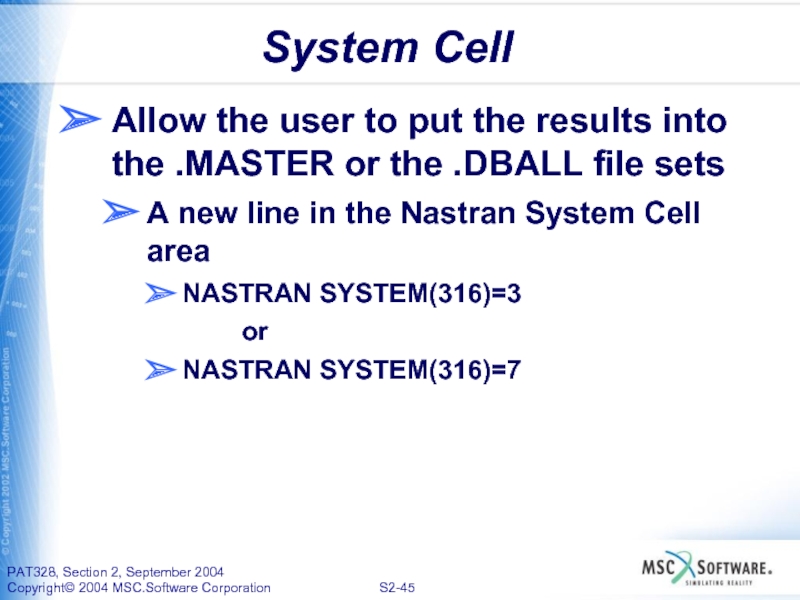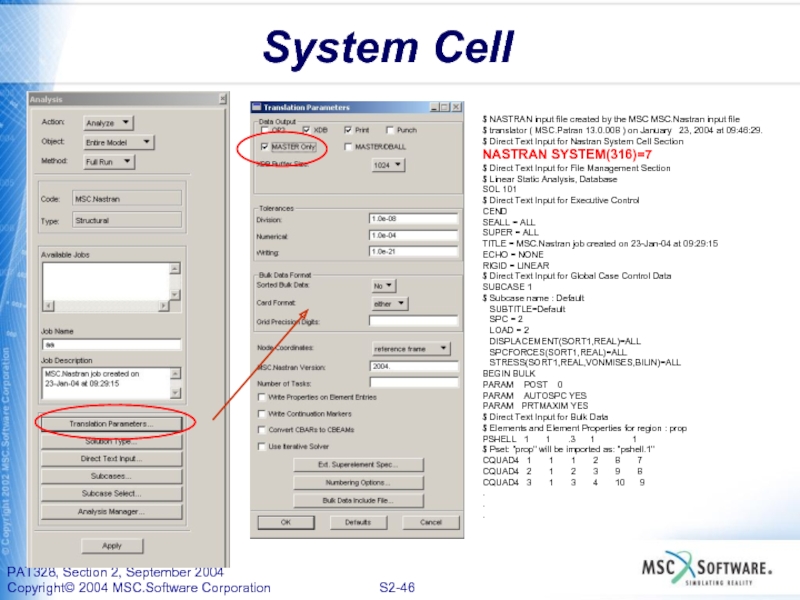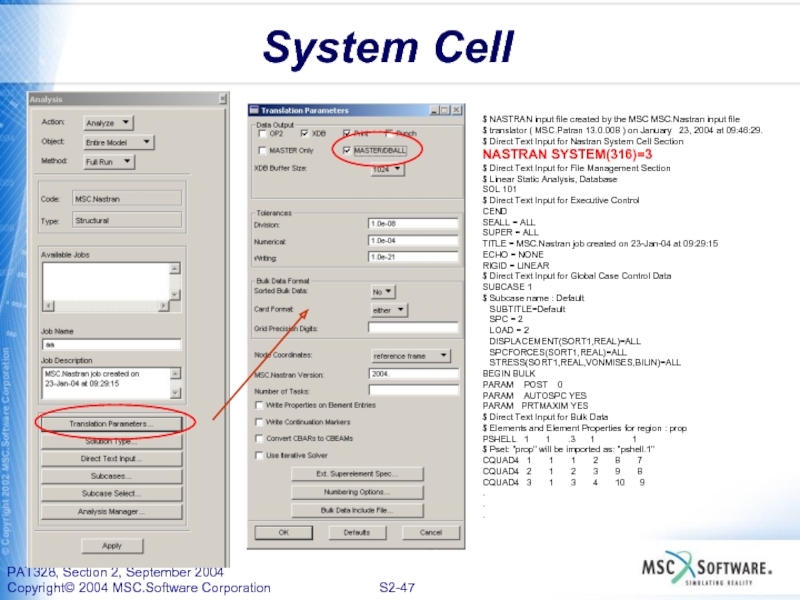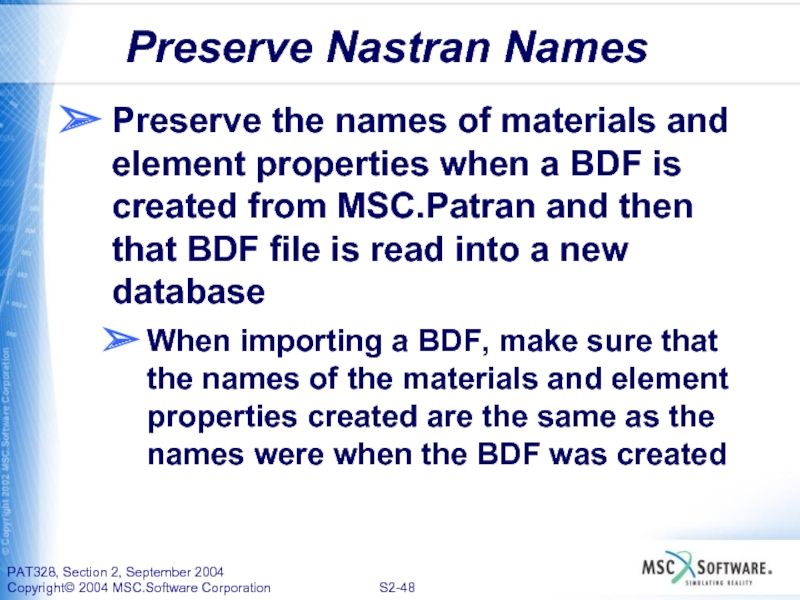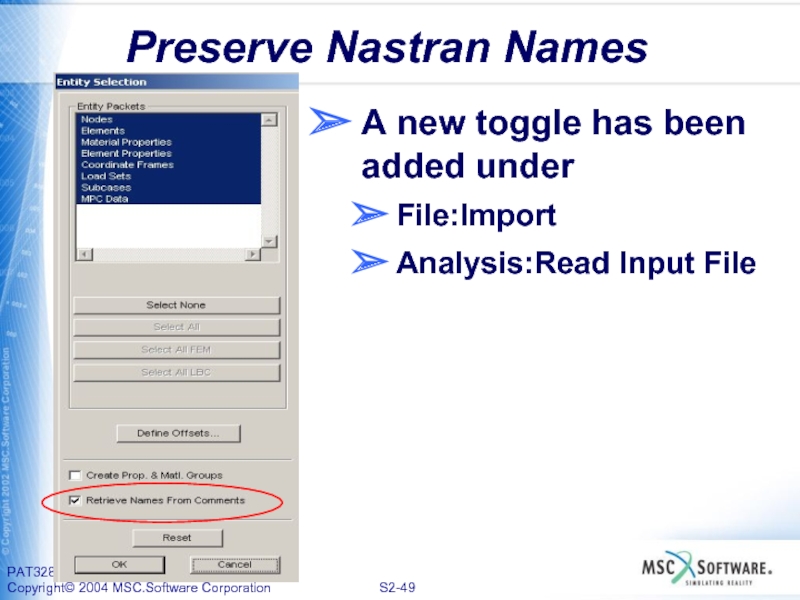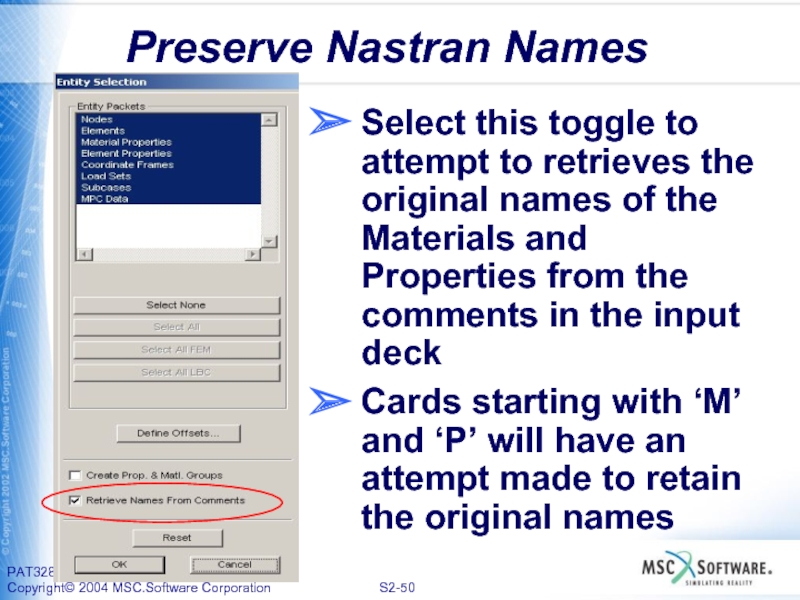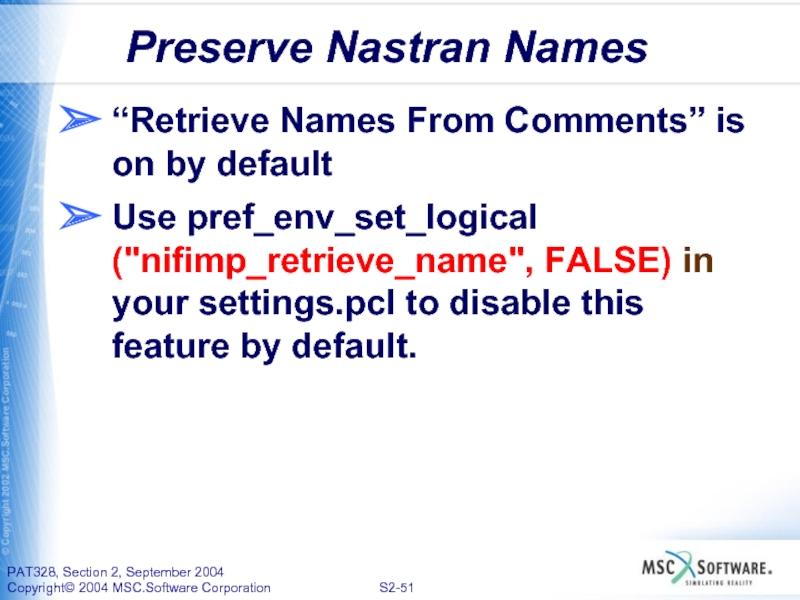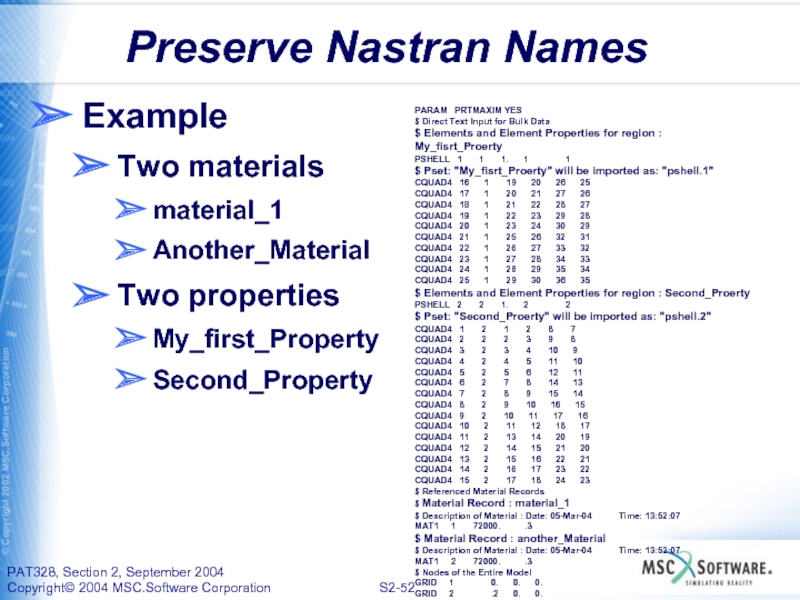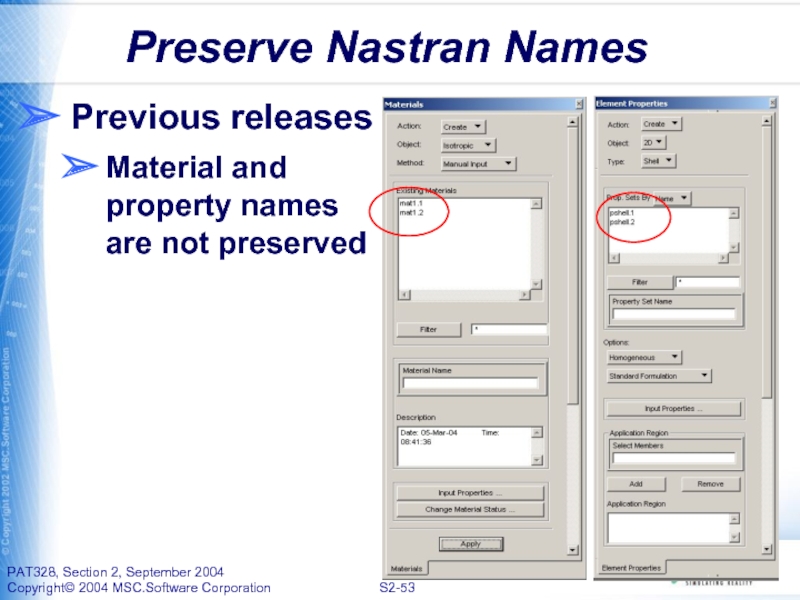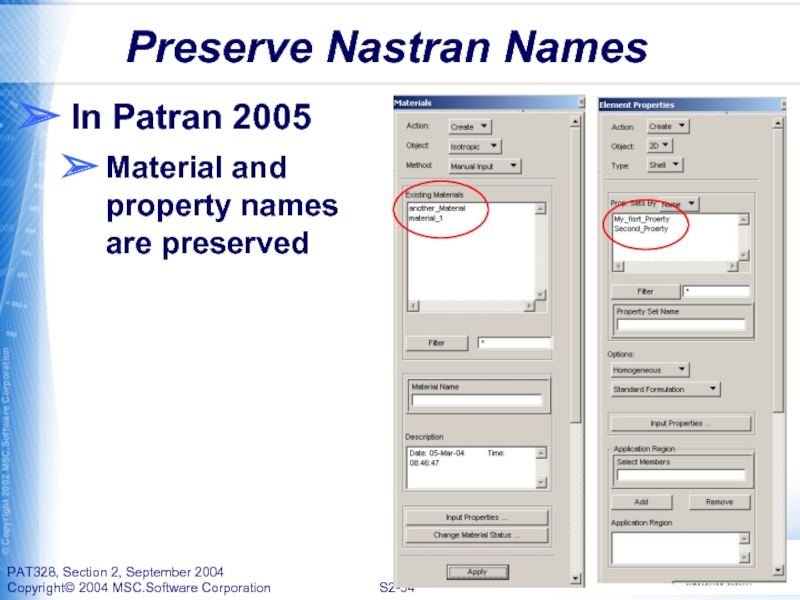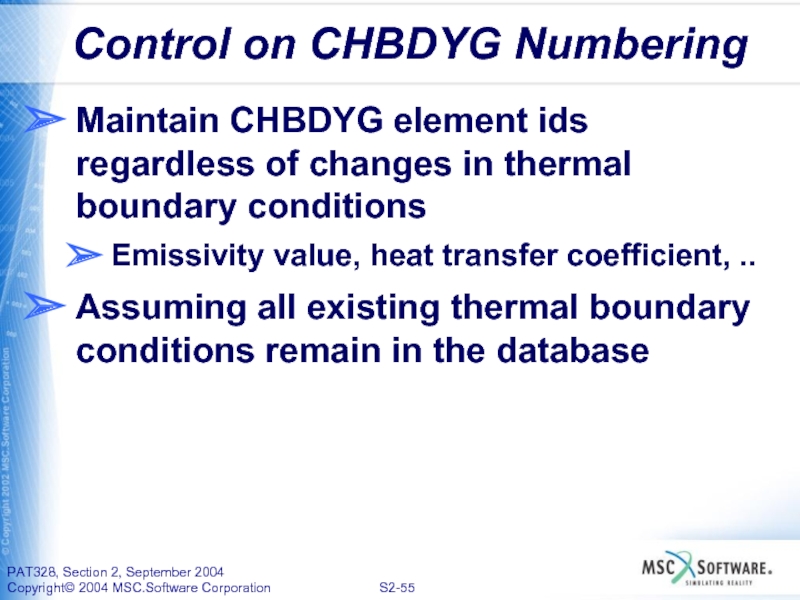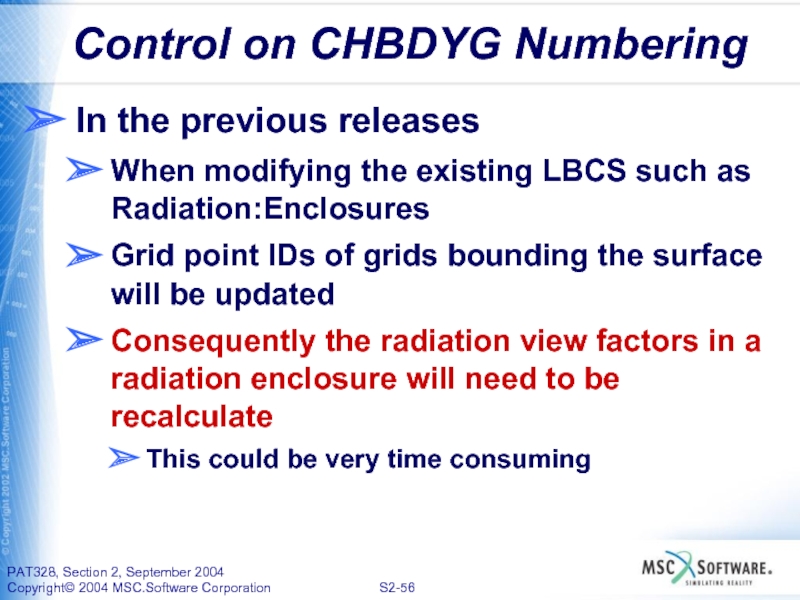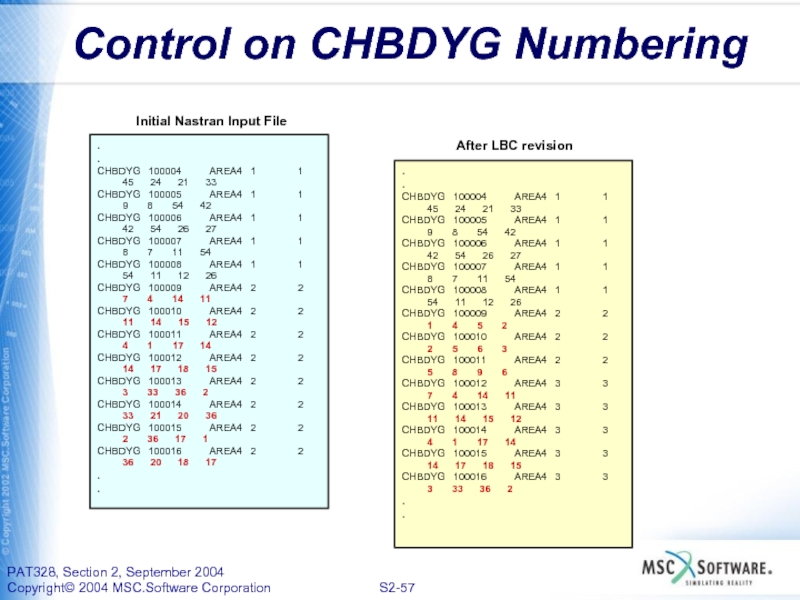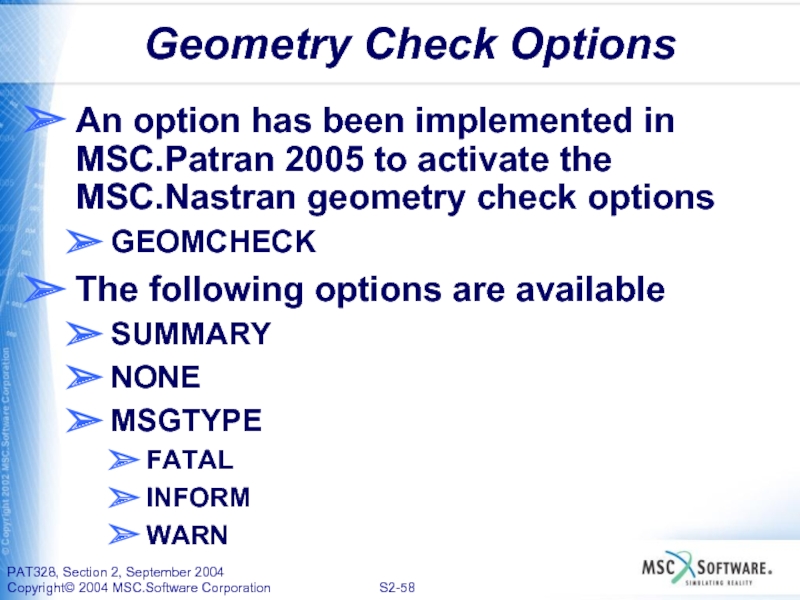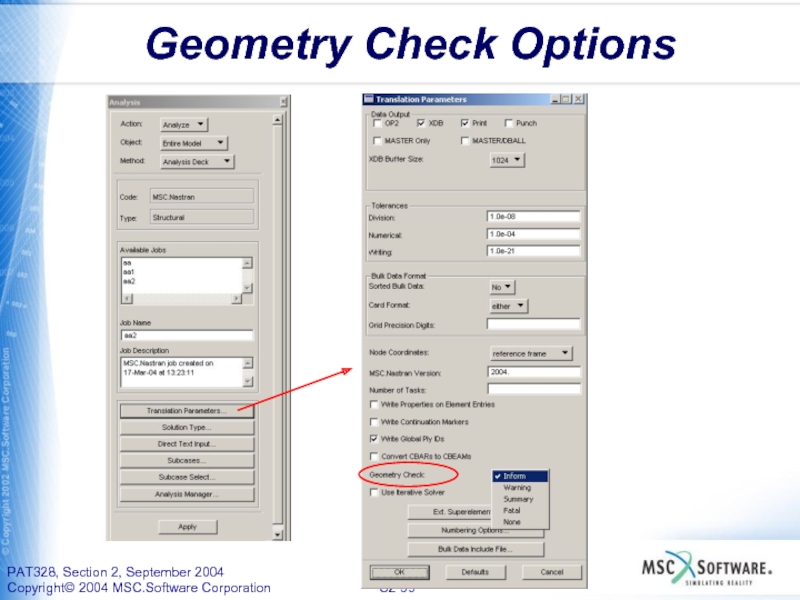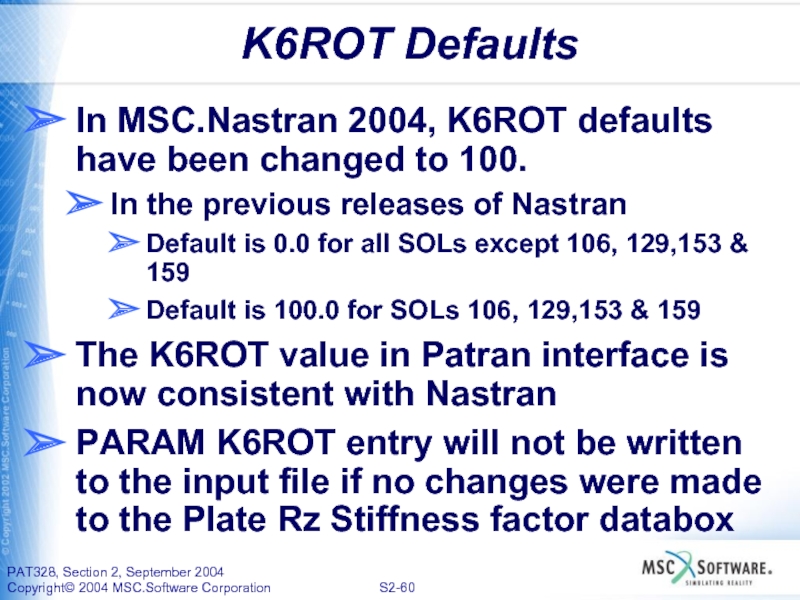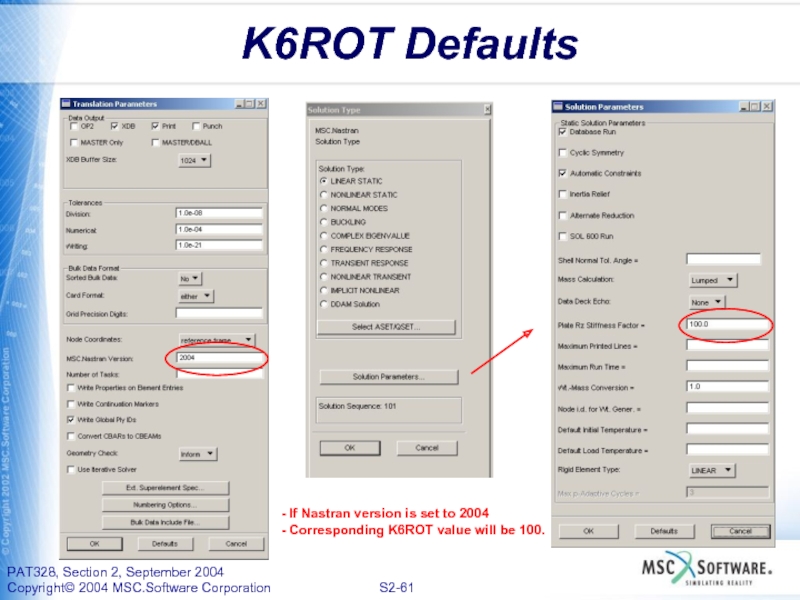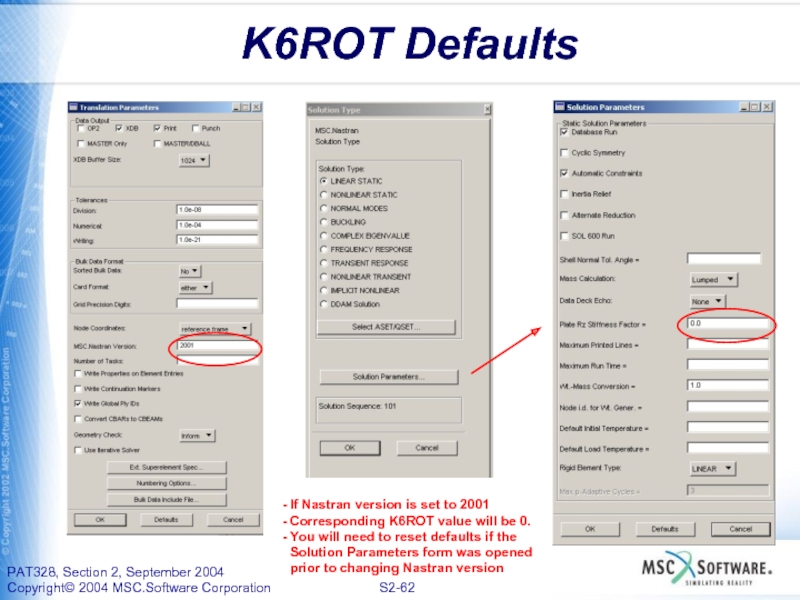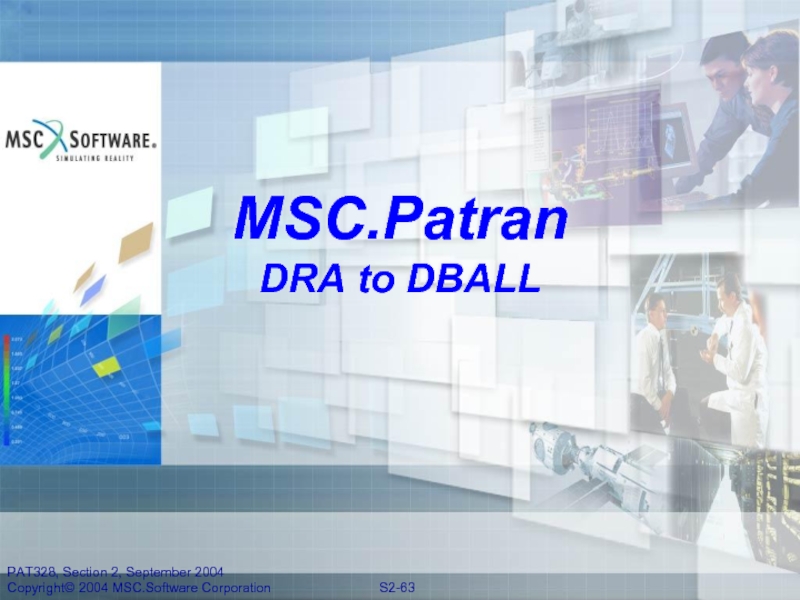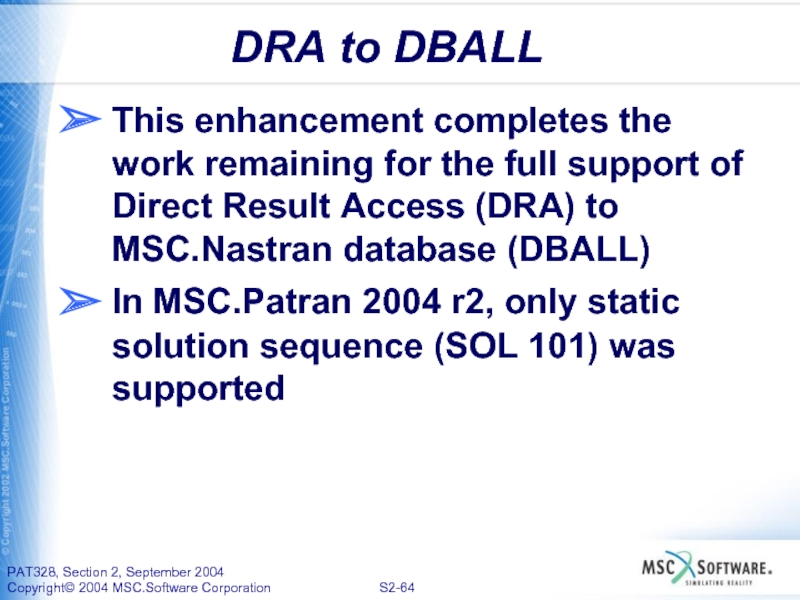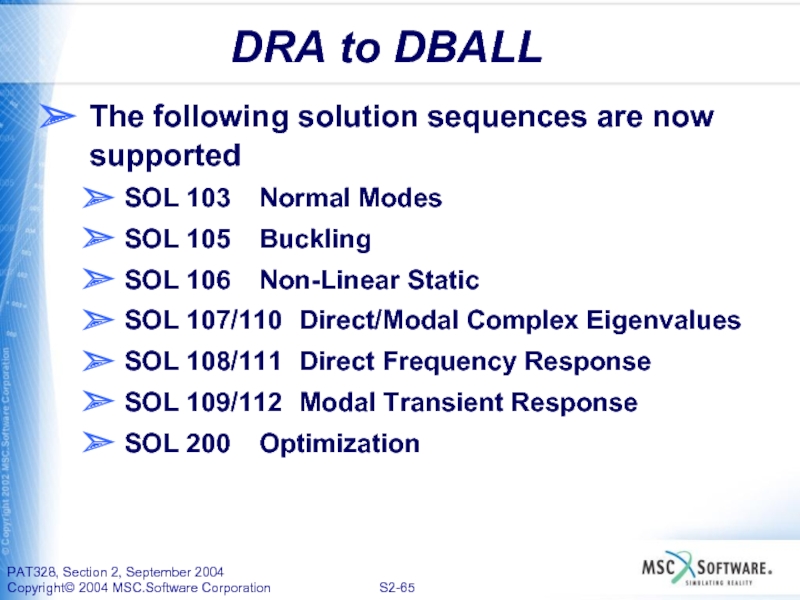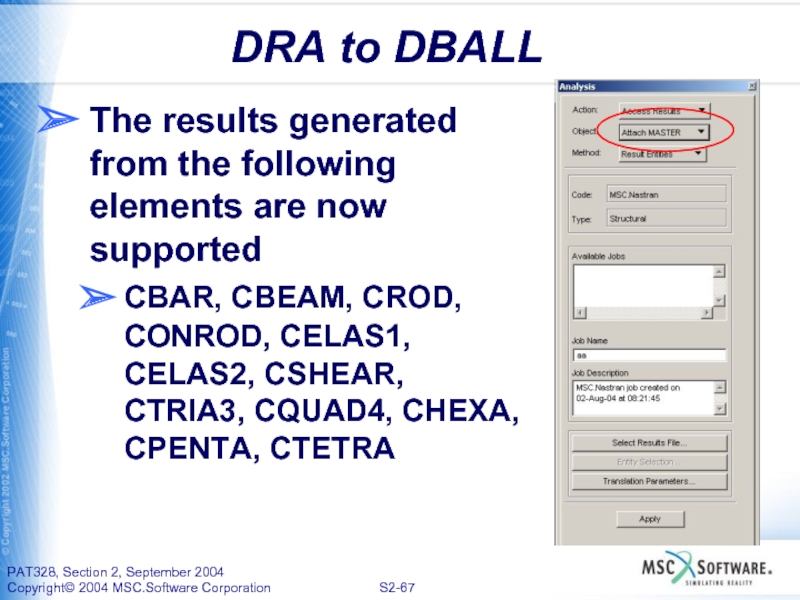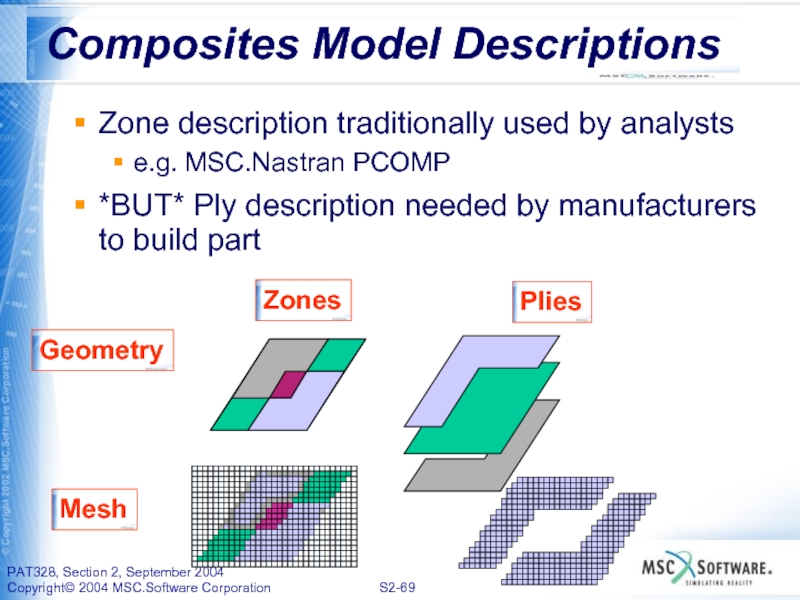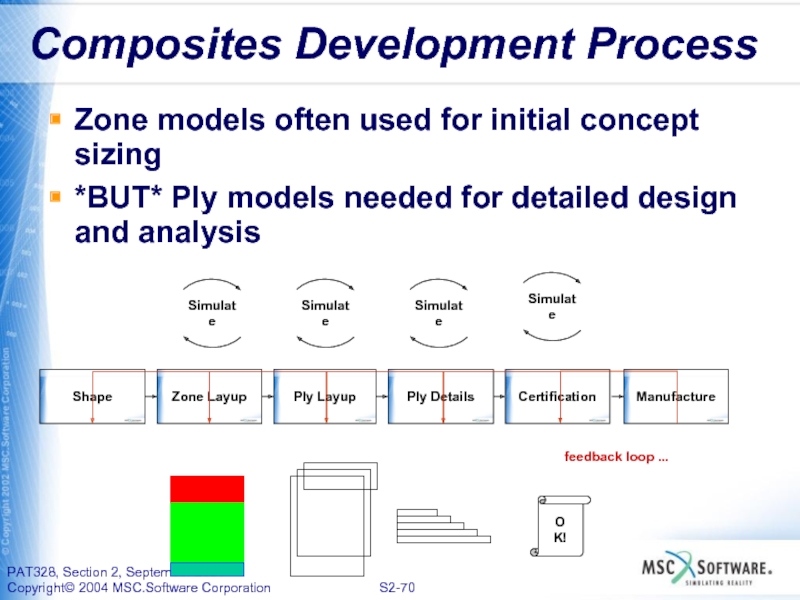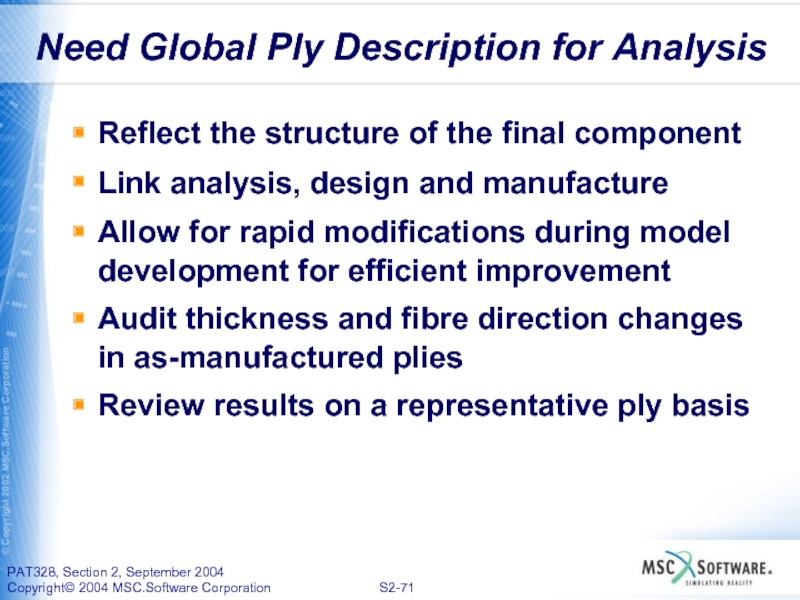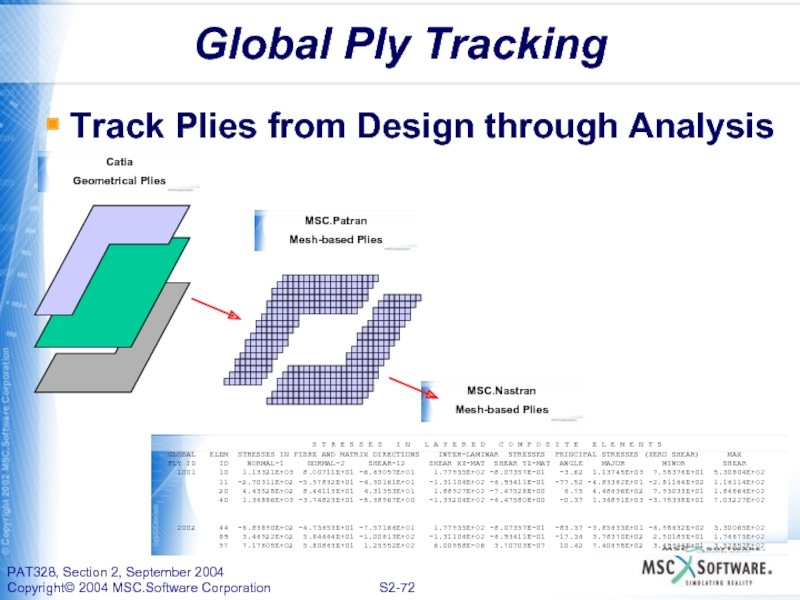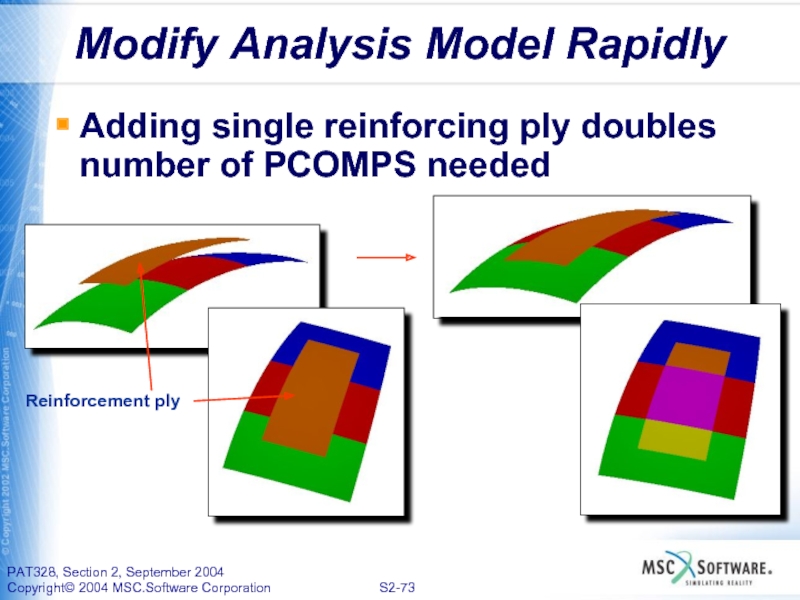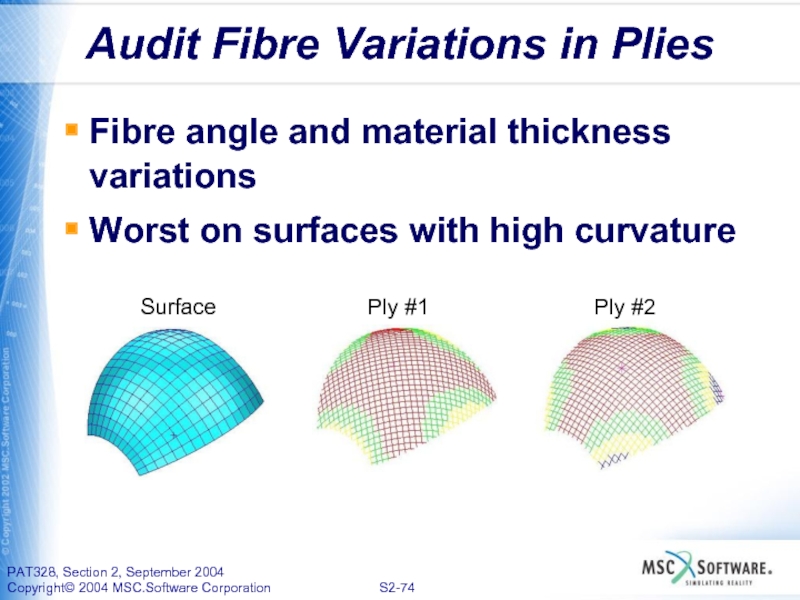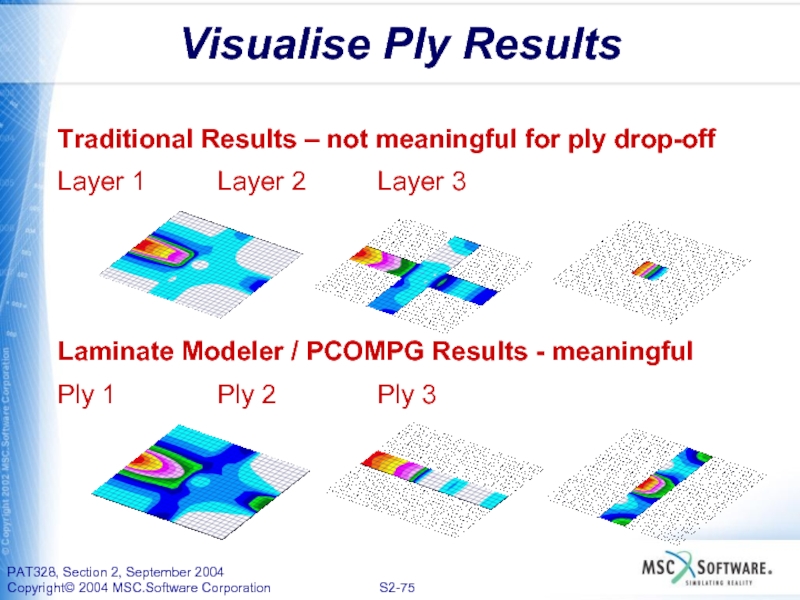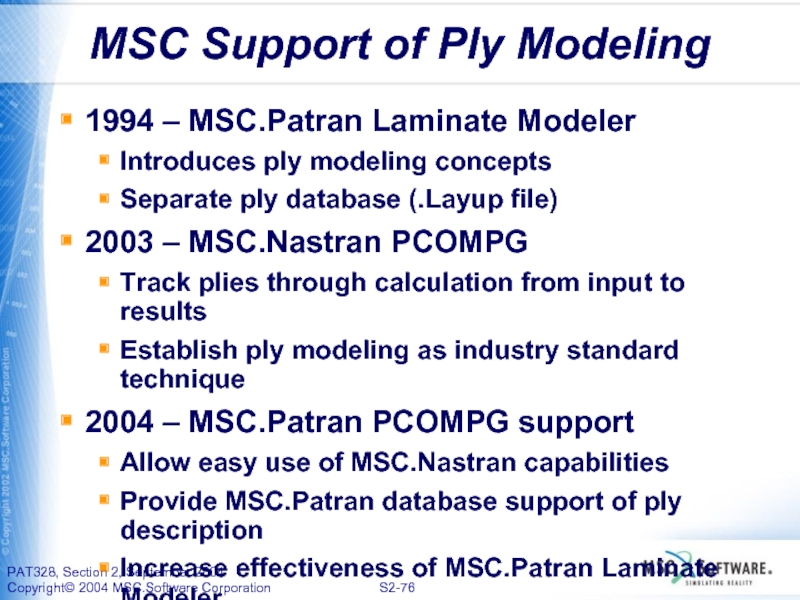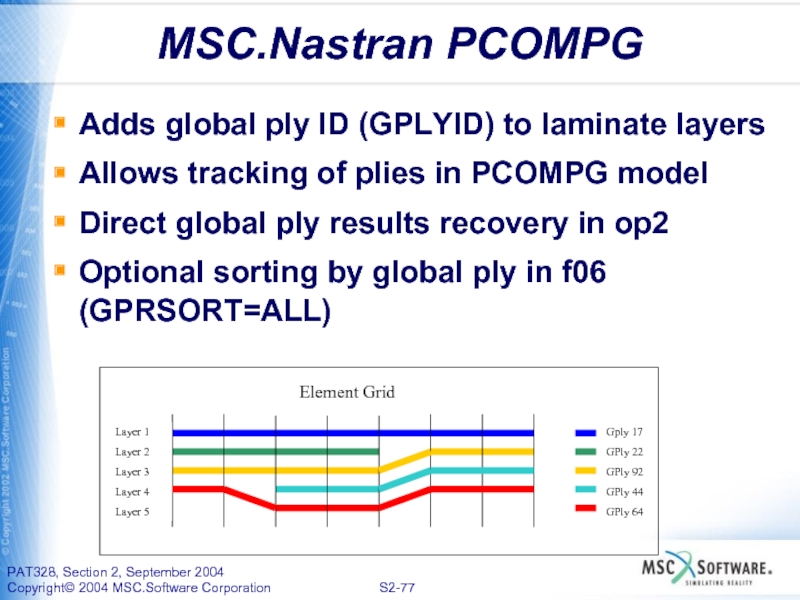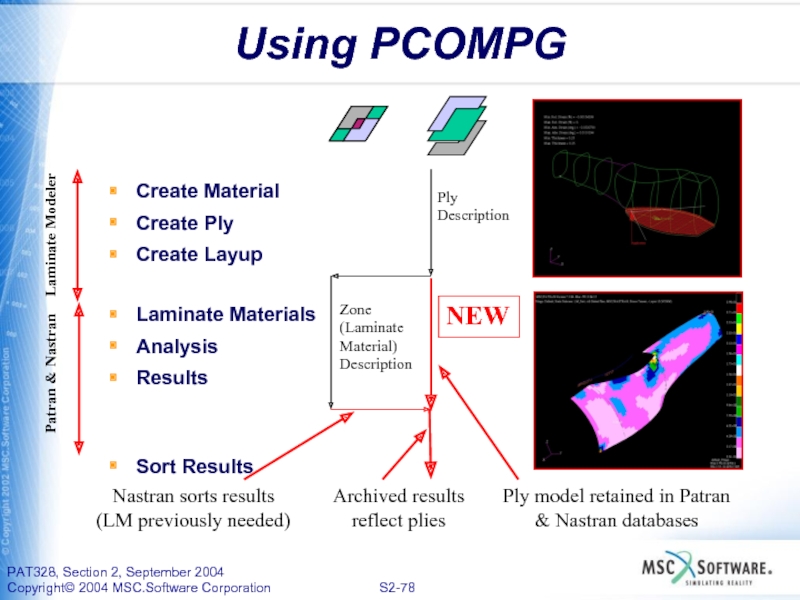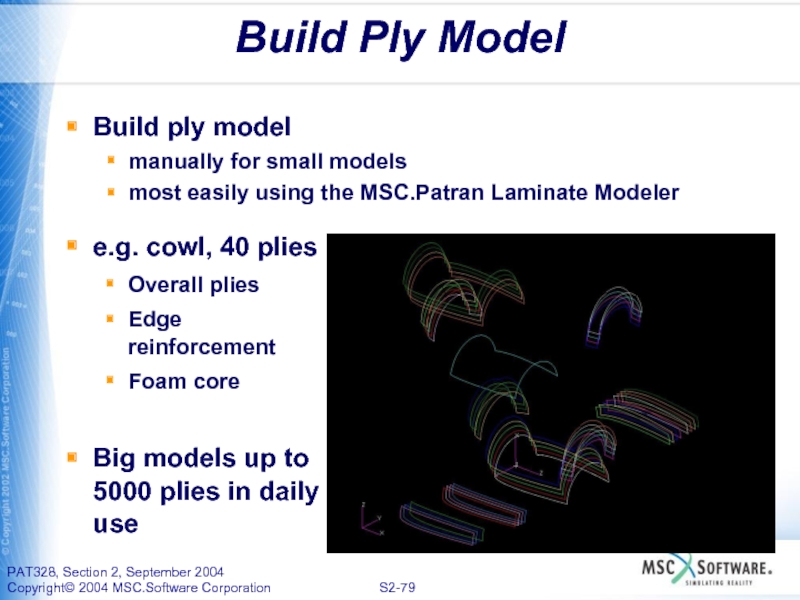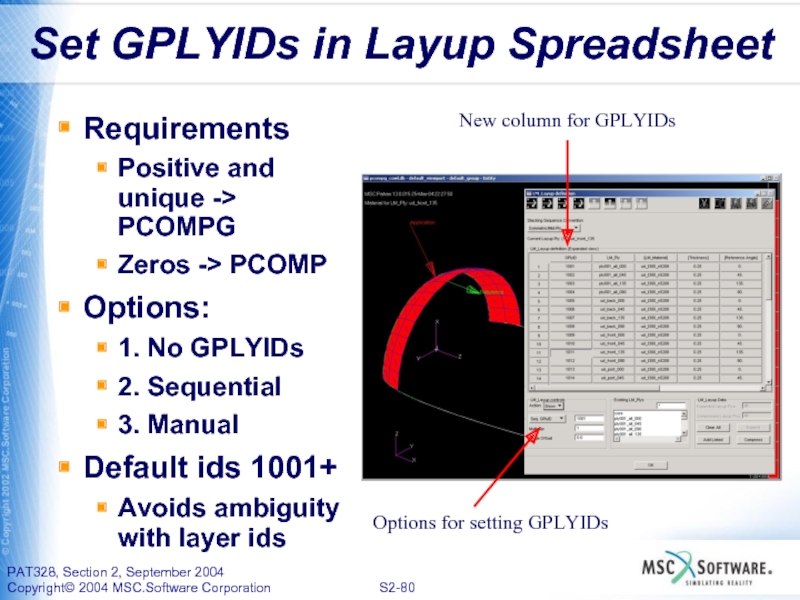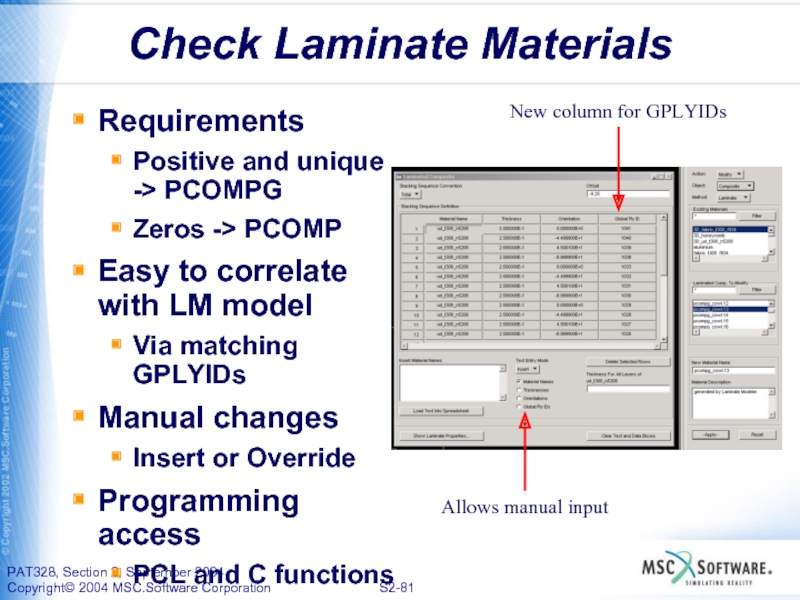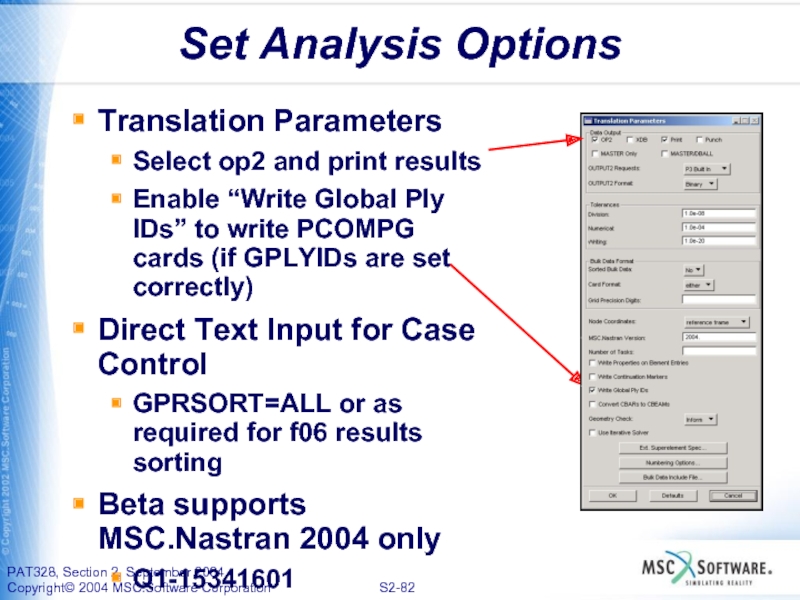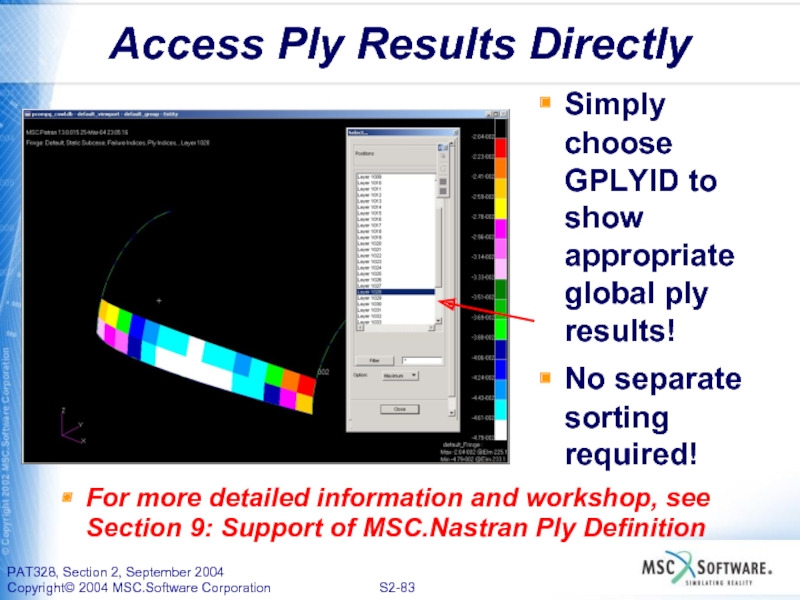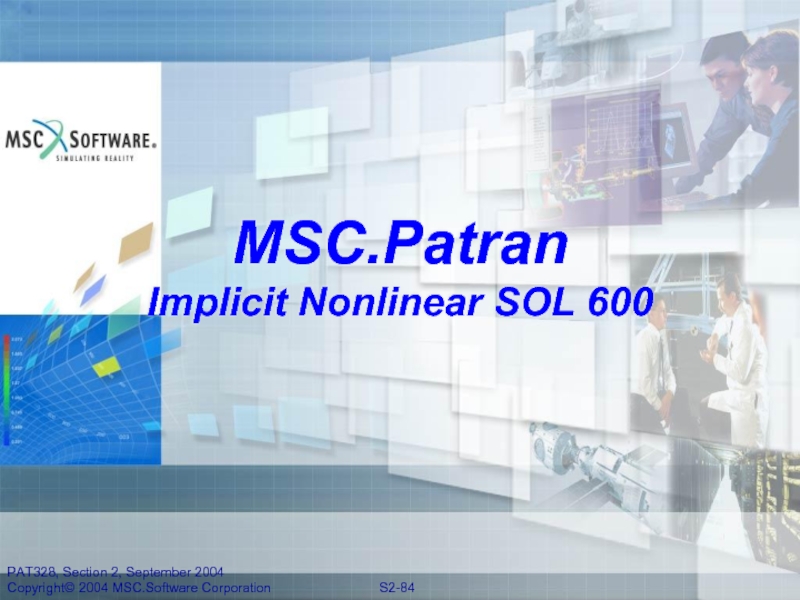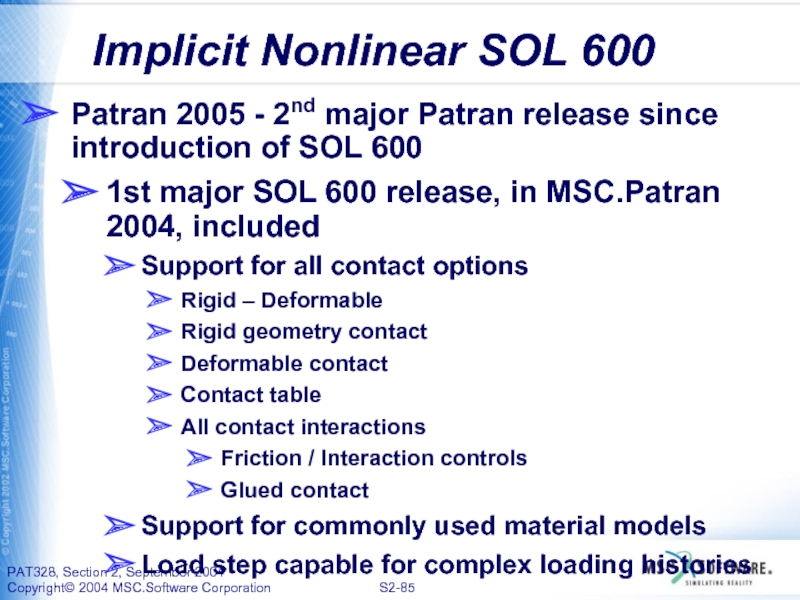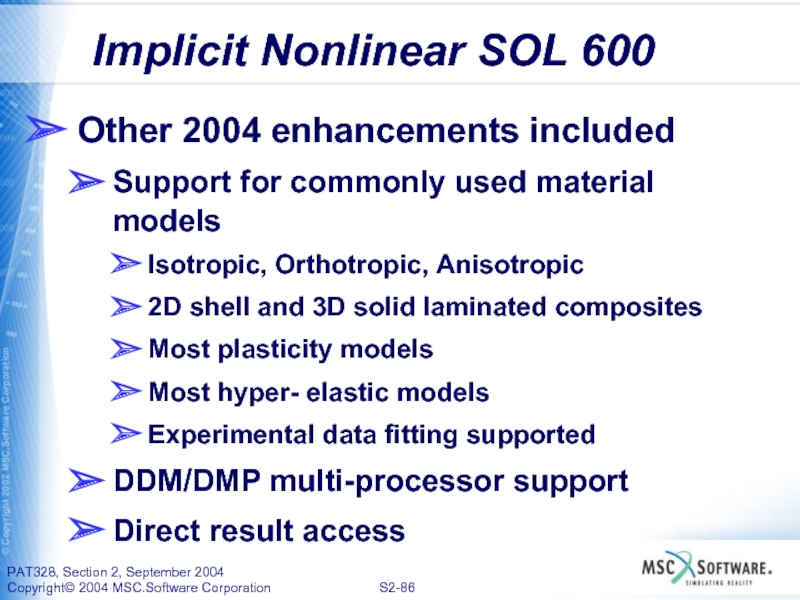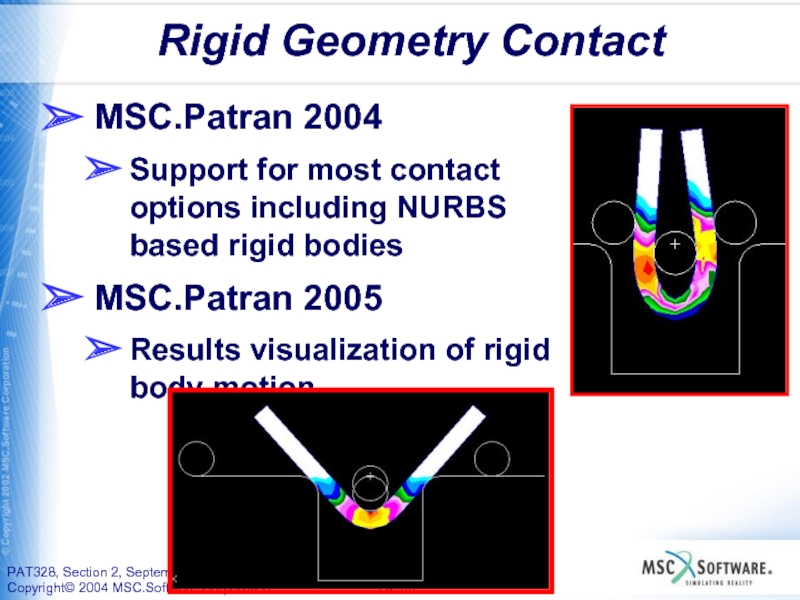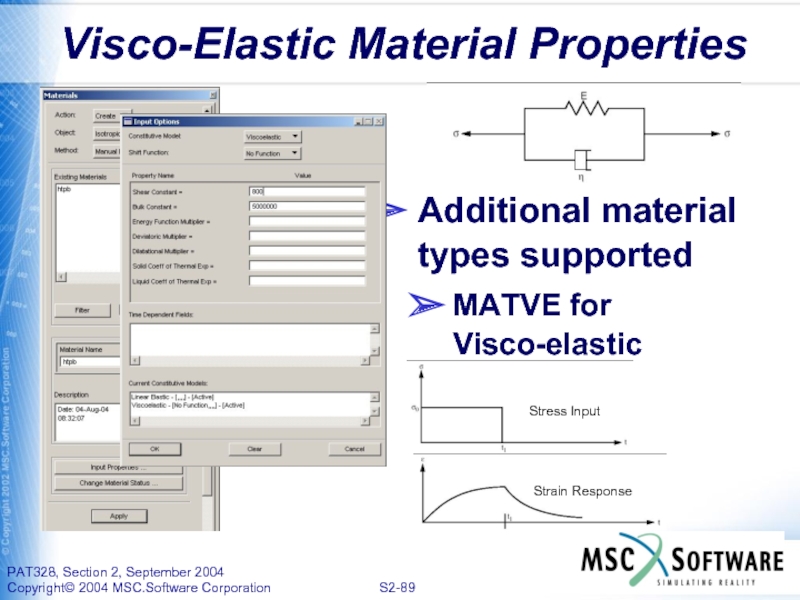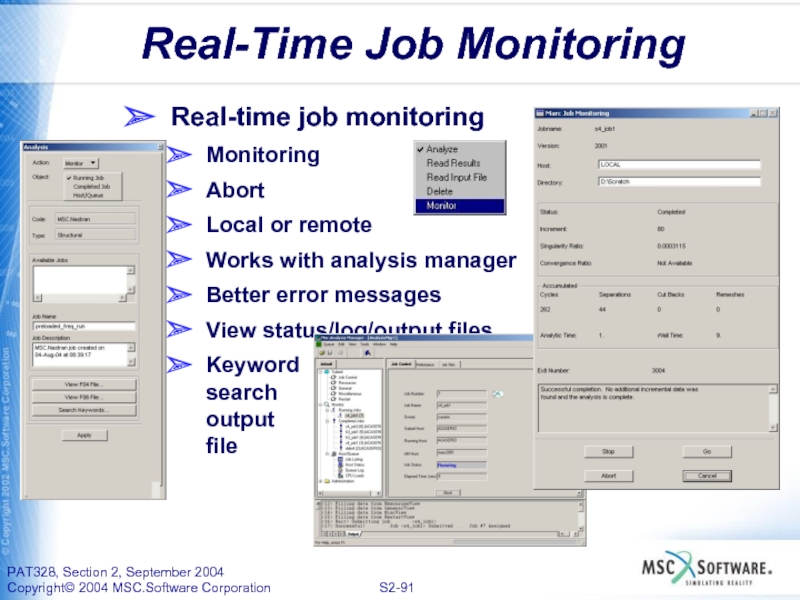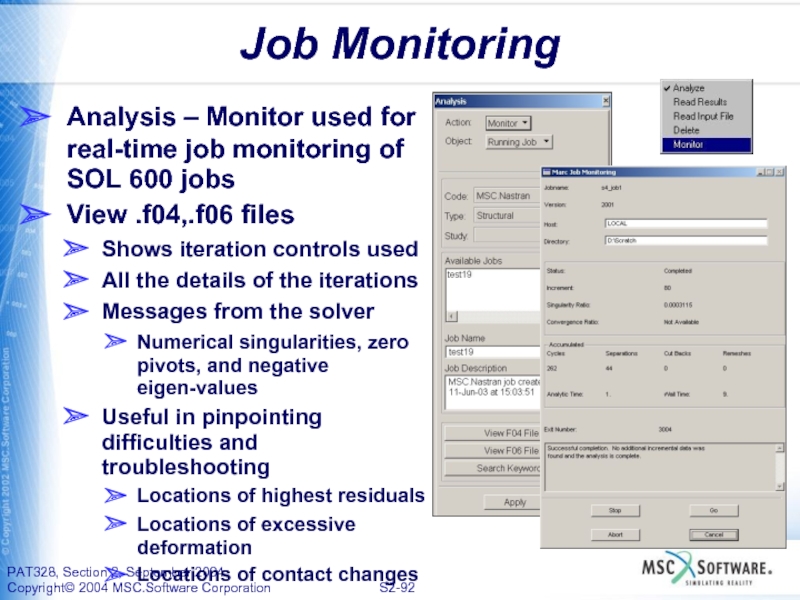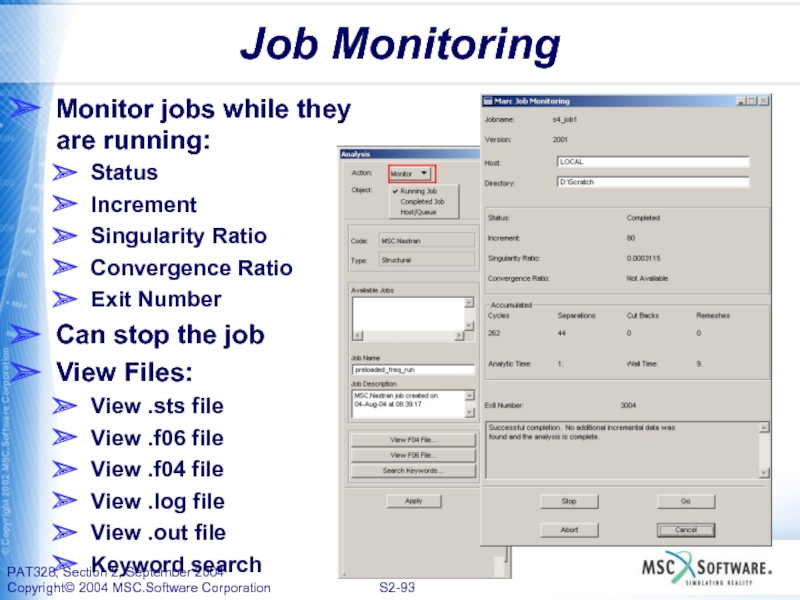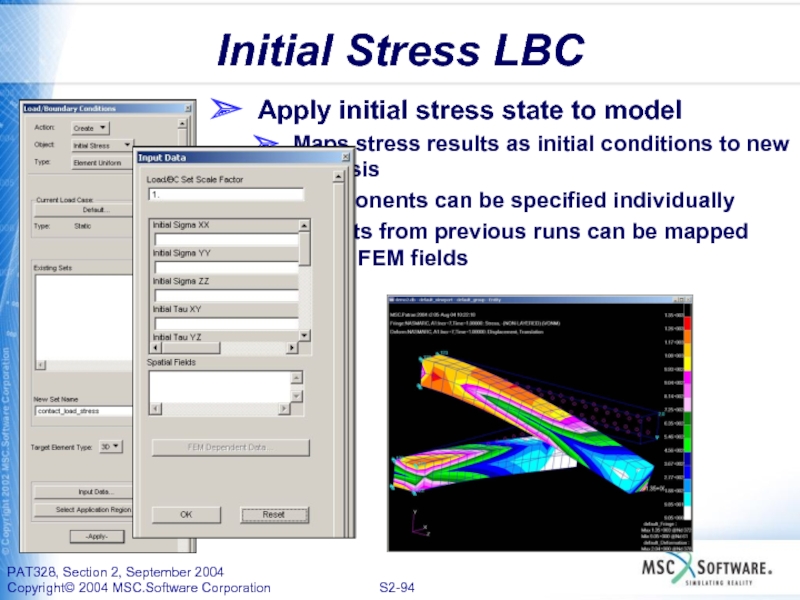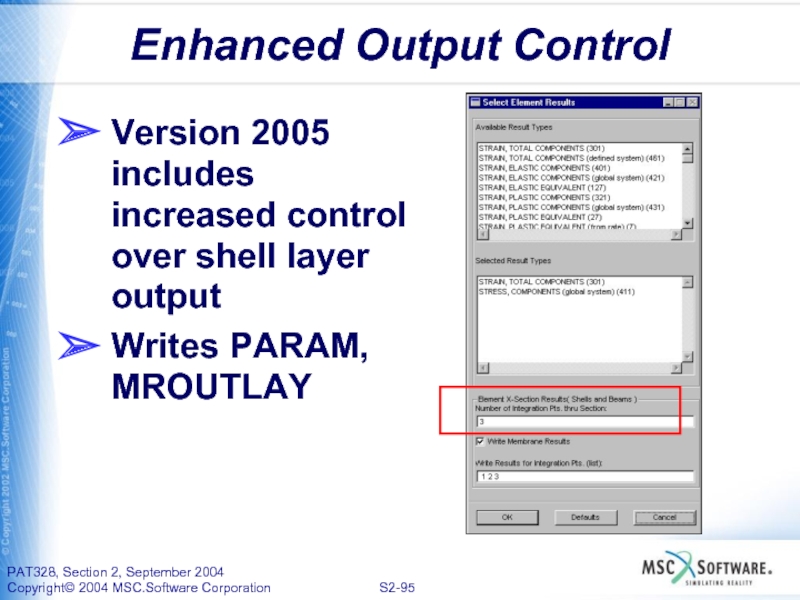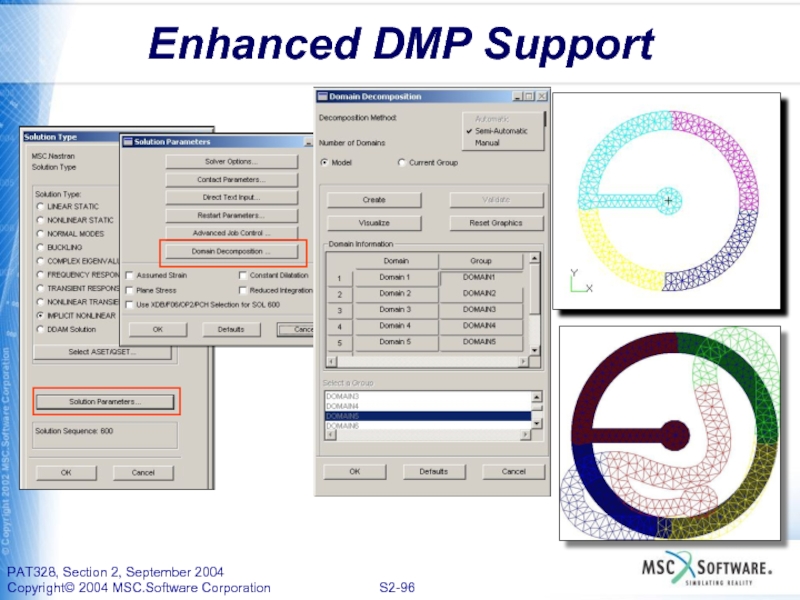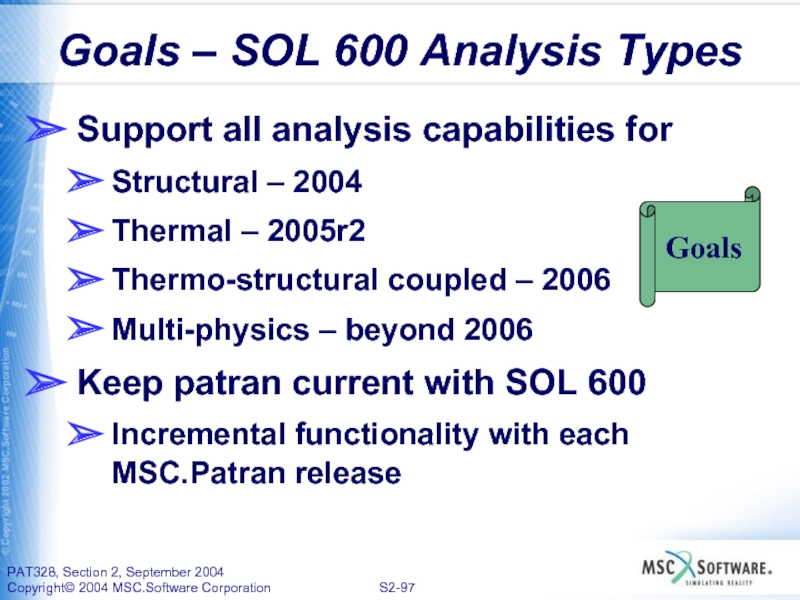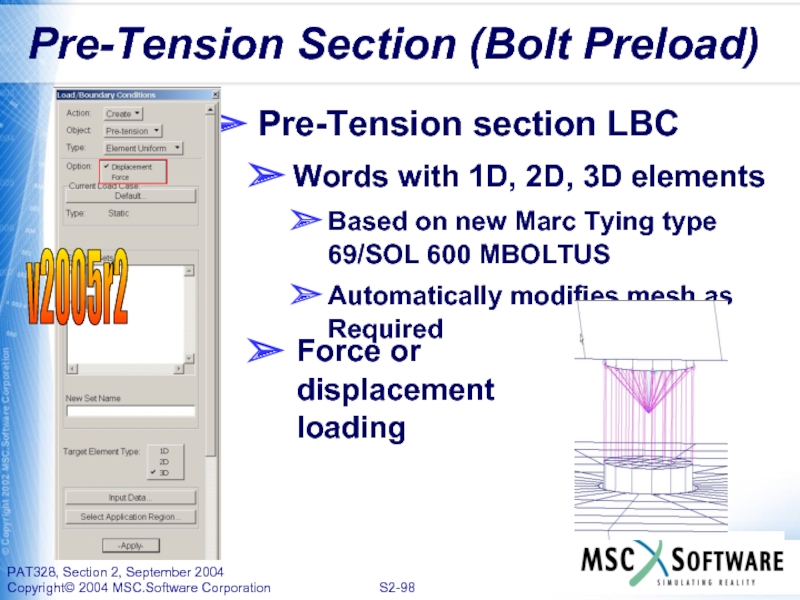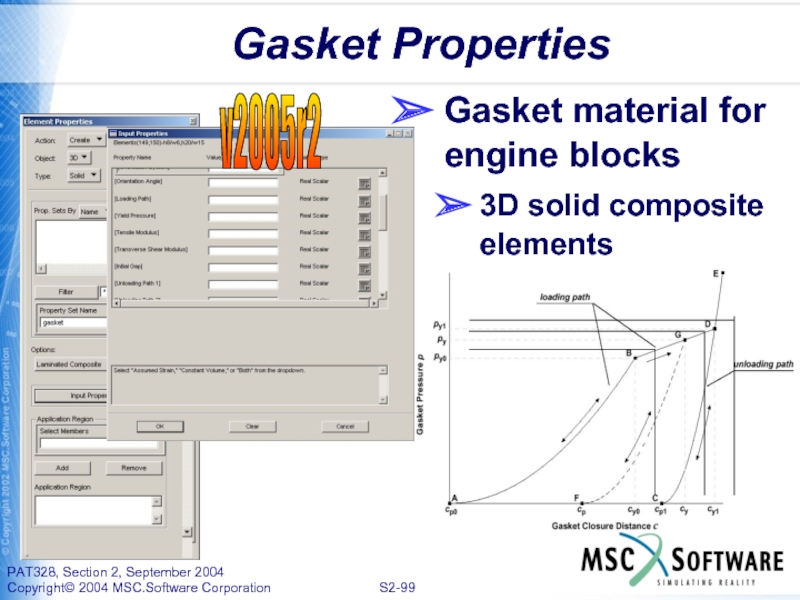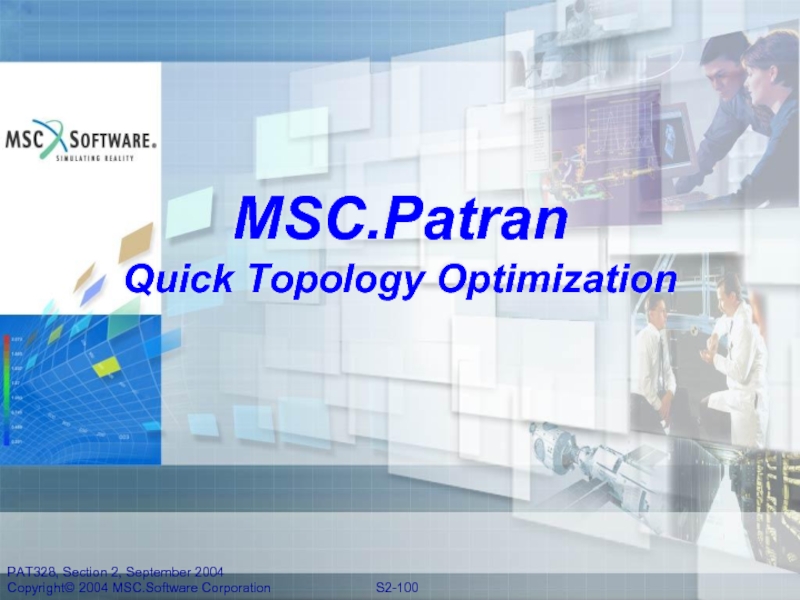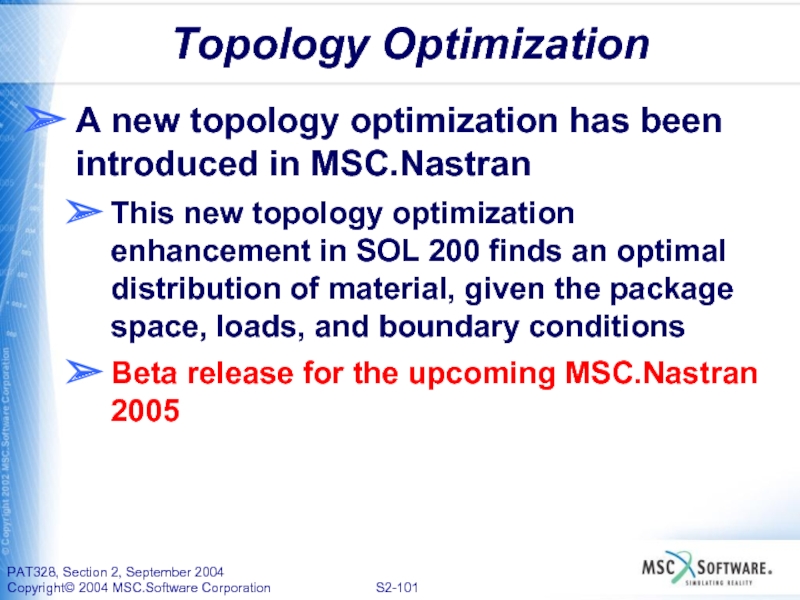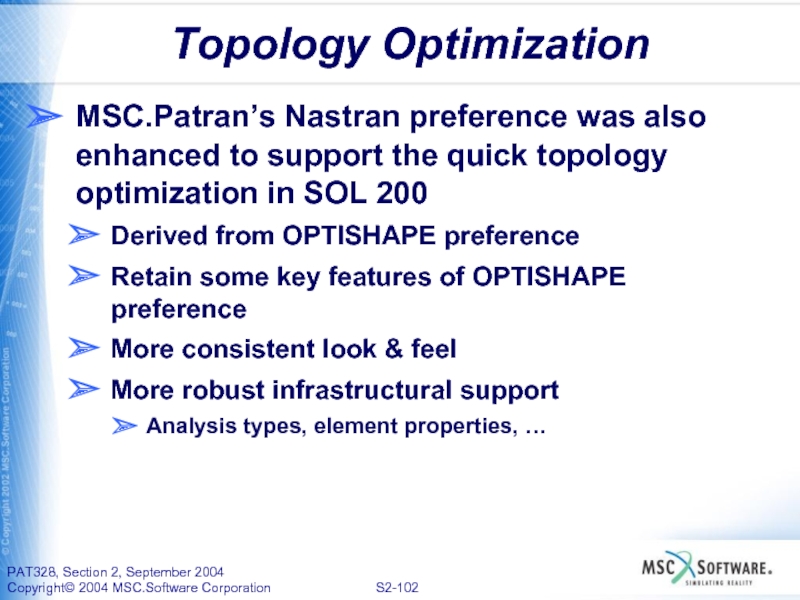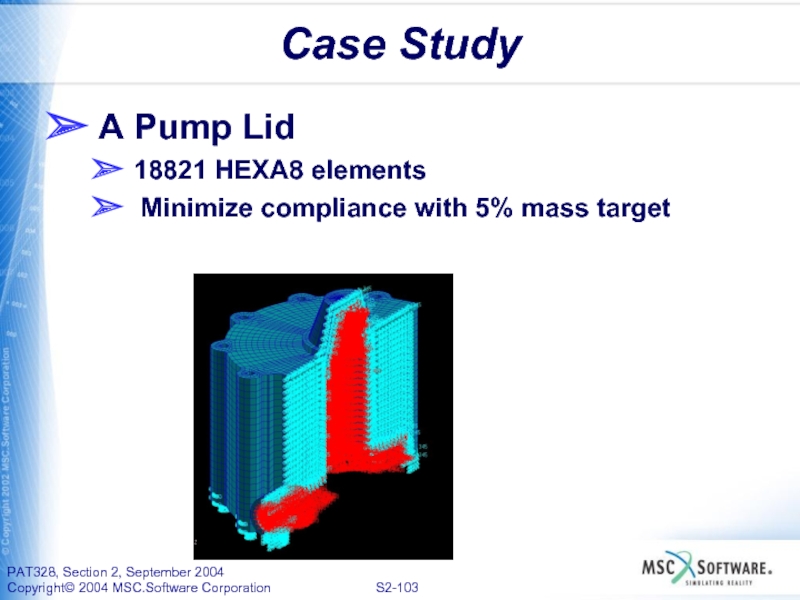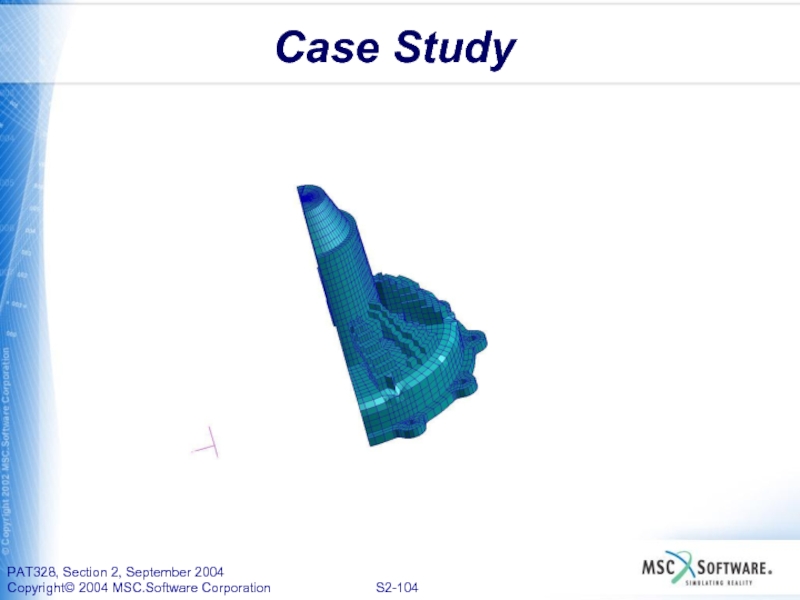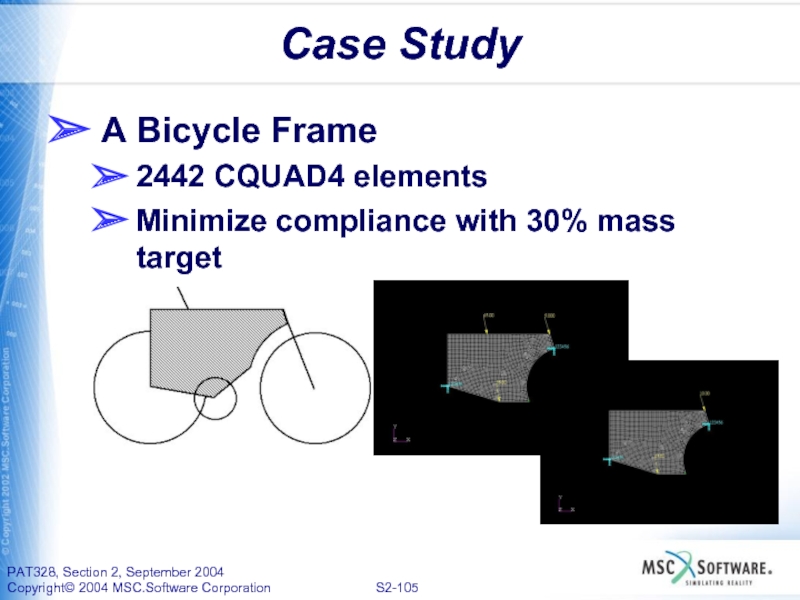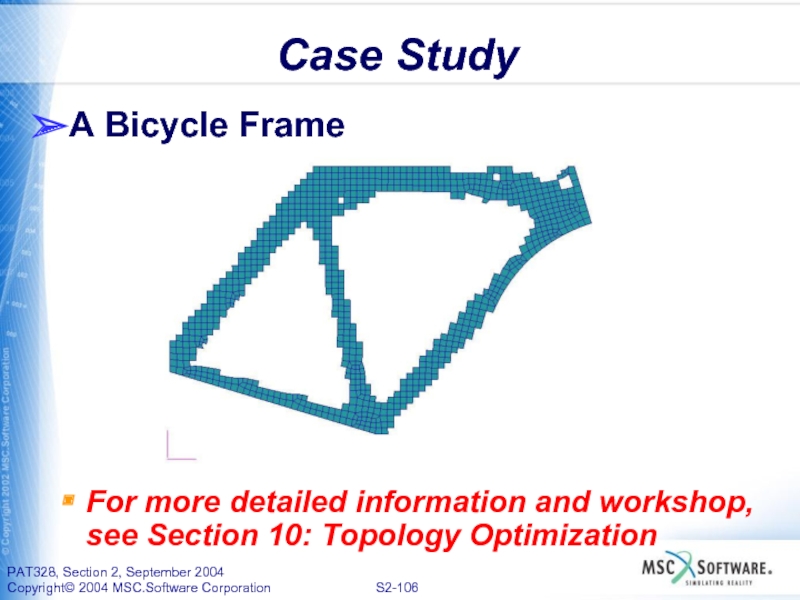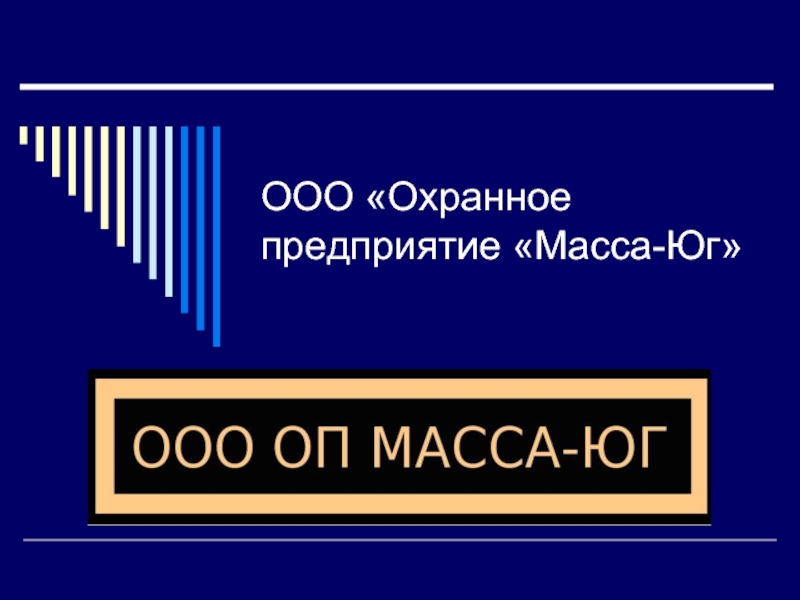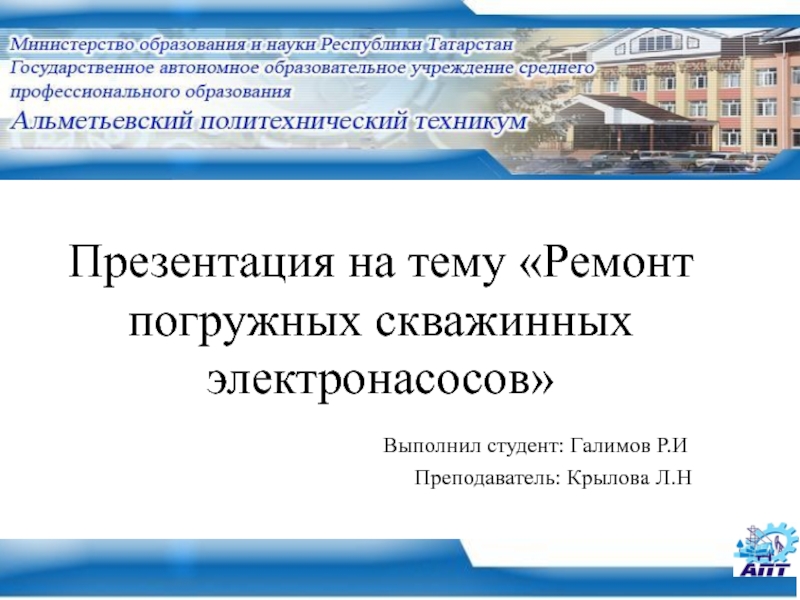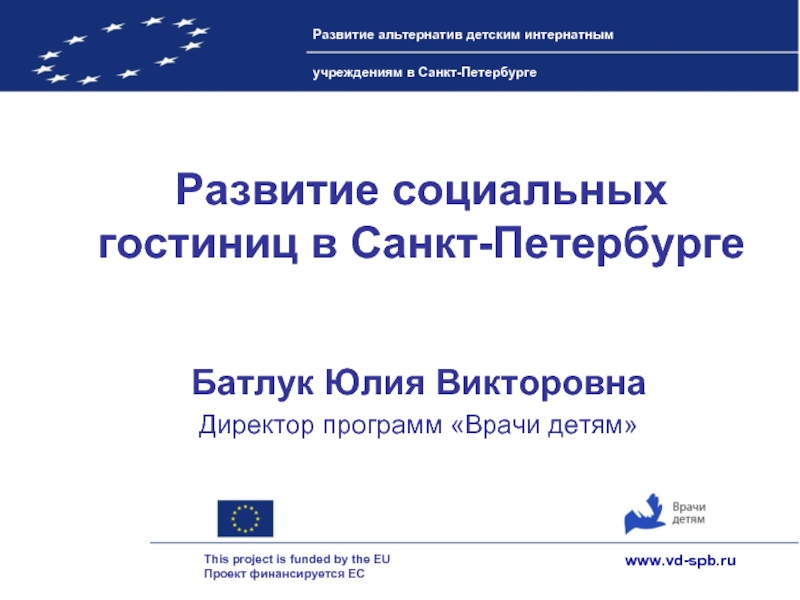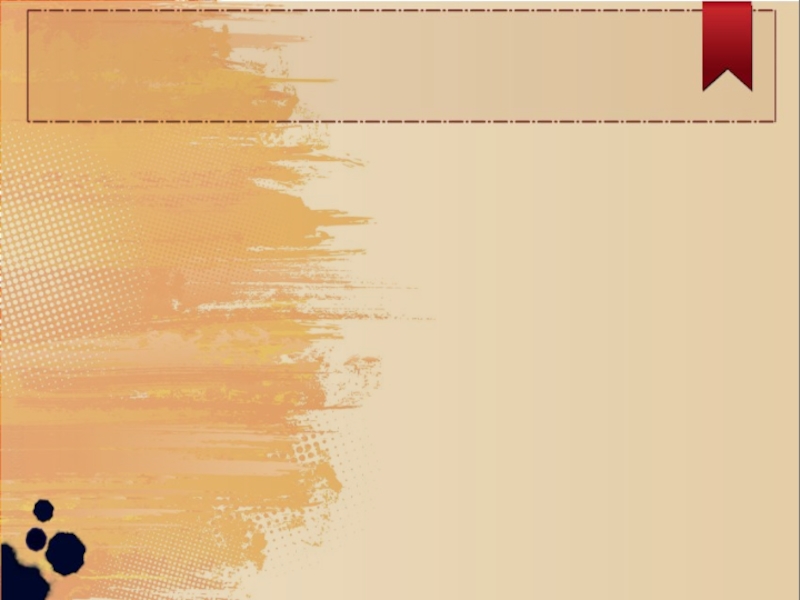- Главная
- Разное
- Дизайн
- Бизнес и предпринимательство
- Аналитика
- Образование
- Развлечения
- Красота и здоровье
- Финансы
- Государство
- Путешествия
- Спорт
- Недвижимость
- Армия
- Графика
- Культурология
- Еда и кулинария
- Лингвистика
- Английский язык
- Астрономия
- Алгебра
- Биология
- География
- Детские презентации
- Информатика
- История
- Литература
- Маркетинг
- Математика
- Медицина
- Менеджмент
- Музыка
- МХК
- Немецкий язык
- ОБЖ
- Обществознание
- Окружающий мир
- Педагогика
- Русский язык
- Технология
- Физика
- Философия
- Химия
- Шаблоны, картинки для презентаций
- Экология
- Экономика
- Юриспруденция
Section 2 Nastran Preference Enhancements презентация
Содержание
- 1. Section 2 Nastran Preference Enhancements
- 2. Development Focus New enhancements in MSC.Patran 2005
- 3. Development Focus New enhancements in MSC.Patran 2005
- 4. CWELD/CFAST Elements MSC.Nastran connector elements are now
- 5. CWELD/CFAST Elements Two methods to define Spot
- 6. CWELD/CFAST Elements 4 types of surface
- 7. CWELD/CFAST Elements Fastener (CFAST) connectors The GUI
- 8. Connector User Scenario Create single CWELD Spot
- 9. Connector User Scenario Create single CWELD Spot
- 10. Connector User Scenario Create single CWELD
- 11. Lagrange Rigid Element A new type of
- 12. Lagrange Rigid Element New enhancements include Add
- 13. Rigid Element Type Solution Parameters Addition Support
- 14. Thermal Expansion Coefficient Add Thermal Expansion Coefficient
- 15. New Rigid Elements Three new MPC definitions
- 16. Sol 700 is the Explicit Nonlinear capability
- 17. Applications (structural analysis only) Automotive Crash Wheel Impact Droptest Component Crush MSC.Nastran Preference SOL 700
- 18. Materials Support some of the MSC.Nastran Pref
- 19. Materials MSC.Nastran Preference SOL 700
- 20. Elements & Properties MSC.Nastran Preference SOL 700
- 21. Loads/BCs MSC.Nastran Preference SOL 700
- 22. Analysis Solution Parameters of SOL 700 SOL
- 23. Solution Parameters of SOL 700 MSC.Nastran Preference SOL 700
- 24. MSC.Nastran Preference SOL 700
- 25. SOL 700 Parameters in other solutions MSC.Nastran Preference SOL 700
- 26. Subcase Parameters MSC.Nastran Preference SOL 700
- 27. Subcase Parameters - Contact Table MSC.Nastran Preference SOL 700
- 28. Access Results MSC.Nastran Preference SOL 700
- 29. Other planned implementations Available by July
- 30. Double Precision Support In Patran 2005, the
- 31. Double Precision Support The Nastran input file
- 32. Double Precision Support The modules of writing
- 33. User Scenario The sample Nastran input file
- 34. User Scenario Import the same Nastran input
- 35. User Scenario Import the same Nastran input
- 36. User Scenario Import the same Nastran input
- 37. User Scenario Import the same Nastran input
- 38. External Superelement Several major enhancements to the
- 39. External Superelement
- 40. External Superelement With Data Output type =
- 41. External Superelement With Data Output type =
- 42. System Cell Provide access to system cell
- 43. System Cell Allow the user to enter
- 44. System Cell
- 45. System Cell Allow the user to put
- 46. System Cell $ NASTRAN input
- 47. System Cell $ NASTRAN input
- 48. Preserve Nastran Names Preserve the names of
- 49. Preserve Nastran Names A new toggle has
- 50. Preserve Nastran Names Select this toggle to
- 51. Preserve Nastran Names “Retrieve Names From Comments”
- 52. Preserve Nastran Names Example Two materials material_1
- 53. Preserve Nastran Names Previous releases Material and property names are not preserved
- 54. Preserve Nastran Names In Patran 2005 Material and property names are preserved
- 55. Control on CHBDYG Numbering Maintain CHBDYG element
- 56. Control on CHBDYG Numbering In the previous
- 57. Control on CHBDYG Numbering . . CHBDYG
- 58. Geometry Check Options An option has been
- 59. Geometry Check Options
- 60. K6ROT Defaults In MSC.Nastran 2004, K6ROT defaults
- 61. K6ROT Defaults If Nastran version
- 62. K6ROT Defaults If Nastran version
- 63. MSC.Patran DRA to DBALL
- 64. DRA to DBALL This enhancement completes the
- 65. DRA to DBALL The following solution sequences
- 66. DRA to DBALL DRA to the following
- 67. DRA to DBALL The results generated from
- 68. Nastran PCOMPG Support in Patran 2005
- 69. Composites Model Descriptions Plies Zones Geometry Mesh
- 70. Composites Development Process Zone models often used
- 71. Need Global Ply Description for Analysis Reflect
- 72. Global Ply Tracking Track Plies from Design through Analysis
- 73. Modify Analysis Model Rapidly Adding single reinforcing ply doubles number of PCOMPS needed Reinforcement ply
- 74. Audit Fibre Variations in Plies Fibre angle
- 75. Visualise Ply Results Traditional Results – not
- 76. MSC Support of Ply Modeling 1994 –
- 77. MSC.Nastran PCOMPG Adds global ply ID (GPLYID)
- 78. Using PCOMPG Create Material Create Ply
- 79. Build Ply Model Build ply model
- 80. Set GPLYIDs in Layup Spreadsheet Requirements Positive
- 81. Check Laminate Materials Requirements Positive and unique
- 82. Set Analysis Options Translation Parameters Select op2
- 83. Access Ply Results Directly Simply choose GPLYID
- 84. MSC.Patran Implicit Nonlinear SOL 600
- 85. Patran 2005 - 2nd major Patran release
- 86. Other 2004 enhancements included Support for
- 87. Will continue to add capabilities with SOL
- 88. Rigid Geometry Contact MSC.Patran 2004 Support for
- 89. Visco-Elastic Material Properties Additional material types supported
- 90. New Loading Capabilities Multi-step approach Normal modes
- 91. Real-Time Job Monitoring Real-time job monitoring
- 92. Analysis – Monitor used for real-time job
- 93. Job Monitoring Monitor jobs while they are
- 94. Initial Stress LBC Apply initial stress
- 95. Enhanced Output Control Version 2005 includes increased
- 96. Enhanced DMP Support
- 97. Support all analysis capabilities for Structural –
- 98. Pre-Tension Section (Bolt Preload) Pre-Tension section LBC
- 99. Gasket Properties Gasket material for engine blocks 3D solid composite elements v2005r2
- 100. MSC.Patran Quick Topology Optimization
- 101. Topology Optimization A new topology optimization has
- 102. Topology Optimization MSC.Patran’s Nastran preference was also
- 103. Case Study A Pump Lid 18821 HEXA8
- 104. Case Study
- 105. Case Study A Bicycle Frame 2442 CQUAD4 elements Minimize compliance with 30% mass target
- 106. Case Study A Bicycle Frame
Слайд 2Development Focus
New enhancements in MSC.Patran 2005
CWELD/CFAST Elements
Lagrange Rigid Element
Explicit Nonlinear
Double Precision Support for Input file Import and Export
External Superelement
System Cell
Preserve Nastran Names
Слайд 3Development Focus
New enhancements in MSC.Patran 2005
Control on CHBDYG Numbering
Geometry Check Options
K6ROT
Quick Topology Optimization
PCOMPG Composite Properties
SOL 600
DRA to DBALL
Слайд 4CWELD/CFAST Elements
MSC.Nastran connector elements are now supported as core implementations
Support the
These elements are added as a new FEM entity type throughout the system
Seamless integration to the group, graphics/picking, list-processing, and results sub-systems
For more detailed information and workshop, see Section 8: CWELD and CFAST Connectors
Слайд 5CWELD/CFAST Elements
Two methods to define Spot Weld (CWELD) locations
Projection: specifies a
The point specified for the Projection method is projected onto each surface patch
Nodes are generated at those locations, and the Pierce Nodes, GA and GB, are assigned the new node ids.
Axis: specifies nodes directly for GA and GB
Nodes specified for the Axis method define the GA and GB piercing nodes directly
Слайд 6CWELD/CFAST Elements
4 types of surface patch A to surface patch B
Elem to Elem (ELEMID and ALIGN formats)
Patch to Patch (ELPAT format)
Prop to Prop (PARTPAT format)
Node to Node (GRIDID format)
Слайд 7CWELD/CFAST Elements
Fastener (CFAST) connectors
The GUI for creating, modifying, showing, and deleting
There are two primary differences
CFAST only has two formats, PROP and ELEM
Analogous to PARTPAT and ELPAT of CWELD respectively
Other than the diameter specification, the PFAST properties are completely different than PWELD
D The diameter (> 0.0, required)
MCID The element stiffness coordinate system (>= -1, default -1)
MFLAG = 0, MCID is relative (default) = 1, MCID is absolute
KTi Stiffness values in directions 1-3 (real, required)
KRi Rotational stiffness values in directions 1-3 (default 0.0)
MASS Lumped mass of the fastener (default 0.0)
Слайд 8Connector User Scenario
Create single CWELD
Spot weld location – Node 2019
With Projection
Connectivity type – Prop to Prop
Property set pcomp.11 to innen
Diameter - 4
Node 2019
Surface Patch A w/ Property pcomp.11
Surface Patch B w/ Property innen
Слайд 9Connector User Scenario
Create single CWELD
Spot weld location – Node 2019
With Projection
Connectivity type – Prop to Prop
Property set pcomp.11 to innen
Diameter - 4
Spot Weld Connector created
Слайд 10Connector User Scenario
Create single CWELD
.
.
$ Elements and Element Properties for region
PSHELL 1 2 7.5 2 2
.
.
$ Elements and Element Properties for region : pcomp.11
$ Composite Property Record created from P3/PATRAN composite material
$ record : pcomp.11
$ Composite Material Description :
PCOMP 11 -1.5 0. 0. SYM
111 .125 45. YES 111 .125 90. YES
111 .125 -45. YES 111 .125 -45. YES
111 .125 0. YES 111 .125 45. YES
111 .125 0. YES 111 .125 45. YES
111 .125 0. YES 111 .125 0. YES
111 .125 -45. YES 111 .125 0. YES
.
.
$ Connector elements and properties for region : prop_2019
PWELD 8 1 4. OFF SPOT
CWELD 1 8 2019 PARTPAT 2020 2021
1 11
.
.
GRID 2019 95. 25. 104.75
GRID 2020 95. 25. 102.75
GRID 2021 95. 25. 95
Automatic creation of GA & GB
Слайд 11Lagrange Rigid Element
A new type of Rigid Element was introduced by
Lagrange Rigid Element
MSC.Patran 2005 supports the new Lagrange Rigid Element type
MSC.Patran 2005 will also support the new rigid element bulk data entries
RBAR1
RTRPLT1
RJOINT
Слайд 12Lagrange Rigid Element
New enhancements include
Add support for the RIGID case control
LINEAR: selects the linear elimination method
LAGR: select the Lagrange multiplier method
LGELIM: select the Lagrange multiplier method with elimination
For solution types 101, 103, 105, 106, 129, and ultimately 400
Add support of the Thermal Expansion Coefficient (ALPHA) value to applicable existing MPC definitions
RBAR, RBE1, RBE2, RBE3, RROD and RTRPLT
Add new rigid element definitions
RBAR1, RTRPLT1 and RJOINT
ALPHA constant is also added for RBAR1 and RTRPLT1
Слайд 13Rigid Element Type
Solution Parameters Addition
Support Nastran RIGID case control entry
SOL 101
$
CEND
SEALL = ALL
SUPER = ALL
TITLE = MSC.Nastran job created on 14-Jan-04 at 17:30:07
ECHO = NONE
RIGID = LINEAR
$ Direct Text Input for Global Case Control Data
SUBCASE 1
$ Subcase name : Default
SUBTITLE=Default
DISPLACEMENT(SORT1,REAL)=ALL
SPCFORCES(SORT1,REAL)=ALL
STRESS(SORT1,REAL,VONMISES,BILIN)=ALL
BEGIN BULK
PARAM POST 0
PARAM AUTOSPC YES
PARAM PRTMAXIM YES
$ Direct Text Input for Bulk Data
$ Elements and Element Properties for region : prop
PSHELL 1 1 .08 1 1
$ Pset: "prop" will be imported as: "pshell.1"
CQUAD4 1 1 1 2 8 7
CQUAD4 2 1 2 3 9 8
RIGID= LINEAR is the default for all solution sequences except SOL 400. For SOL 400, the default is RIGID=LAGRAN.
Слайд 14Thermal Expansion Coefficient
Add Thermal Expansion Coefficient (ALPHA) to applicable existing &
RBAR, RBE1, RBE2, RBE3, RRPD, RTRPLT, RBAR1 & RTRPLT1
.
.
.
CQUAD4 48 1 63 64 70 69
CQUAD4 49 1 64 65 71 70
CQUAD4 50 1 65 66 72 71
$ Referenced Material Records
$ Material Record : alum
$ Description of Material : Date: 14-Jan-04 Time: 17:28:52
MAT1 1 1.+7 .3
$ Multipoint Constraints of the Entire Model
$ ID conflict : the PATRAN MPC ID was 1
RBE2 51 999 123 6 12 18 24 30
36 37 43 49 55 61 67 13.1-6
$ Nodes of the Entire Model
GRID 1 0. 0. 0.
GRID 2 2. 0. 0.
GRID 3 4. 0. 0.
.
.
.
Слайд 15New Rigid Elements
Three new MPC definitions are added
RBAR1, RTRPLT1 & RJOINT
The
Слайд 16Sol 700 is the Explicit Nonlinear capability of MSC.Dytran LS-Dyna solver
MSC.Nastran Preference SOL 700
Слайд 17Applications (structural analysis only)
Automotive Crash
Wheel Impact
Droptest
Component Crush
MSC.Nastran Preference SOL 700
Слайд 18Materials
Support some of the MSC.Nastran Pref structural materials
Support all the LS-Dyna
MSC.Nastran Preference SOL 700
Слайд 22Analysis
Solution Parameters of SOL 700
SOL 700 Parameters in other solutions
SOL 700,
SOL 700, 106 – NonLinear Static
SOL 700, 109 – Direct Transient Response
SOL 700, 129 – NonLinear Transient
Subcase Parameters
Contact Table
Access Results
MSC.Nastran Preference SOL 700
Слайд 29Other planned implementations
Available by July 10th or earlier
Q1-17075302 - translator
Q1-17075305 - translator support for DAMPGBL - Dynamic Relaxation
Q1-17075308 - translator support for sol 700 PARAM using other solution
Q1-17075311 - translator support for extra data in CDAMPn and CELASn
Q1-17075314 - translator support for extra data in contact table BCTABLE
Q1-17075317 - Some of the sol 700 lbcs are not translated
Q1-17075320 - translator support for the lsdyna materials MATDxxx
MSC.Nastran Preference SOL 700
Слайд 30Double Precision Support
In Patran 2005, the Nastran input file reader and
All the values of the FEM data were persisted in single precision in the prior releases of Patran
Patran 2005 will retain all the original number of significant digits during importing and exporting FEM related data for the following FEM related data
Grid coordinates
MPC coefficients
Coordinate coefficient
The number of significant digits maintained is limited to those that fit within a 16 character field
Слайд 31Double Precision Support
The Nastran input file reader, the modules of retrieving
The Nastran input file writer, the modules of retrieving the FEM related data such as grid coordinates, MPC coefficients and coordinate coefficient from Patran database has been updated to retain the double precisions of the values of the FEM data
Слайд 32Double Precision Support
The modules of writing out GRID and MPC bulk
These updates include GRID, MPC, and CORD
The precision is the maximum possible within the constraints of a 16 character field
Allowing for the sign, decimal, and exponent data
The exponent shall use a “D” to denote double precision
Слайд 33User Scenario
The sample Nastran input file contains double precision GRID coordinates
.
.
GRID* 101 1992.38939617492174.311485495328* 43
GRID* 102 1992.38939617492174.311485495328* 44
GRID* 103 1992.38939617492174.311485495328* 45
GRID* 104 1992.38939617492174.311485495328* 46
GRID* 105 1992.38939617492174.311485495328* 47
GRID* 106 1992.38939617492174.311485495328* 48
GRID* 107 1992.38939617492174.311485495328* 49
GRID* 108 1992.38939617492174.311485495328* 50
GRID* 109 1992.38939617492174.311485495328* 51
GRID* 110 1992.38939617492174.311485495328* 52
.
.
Note: This example actually does not take advantage of the double precision. Without a “D” in the exponent, only 8 significant digits will be used by Nastran
Слайд 34User Scenario
Import the same Nastran input file into a prior release
Grid coordinates will be written with single precision
Accuracy of results is questionable
.
.
GRID 101 1992.39 174.312 0.
GRID 102 1992.39 174.312 100.
GRID 103 1992.39 174.312 200.
GRID 104 1992.39 174.312 300.
GRID 105 1992.39 174.312 400.
GRID 106 1992.39 174.312 500.
GRID 107 1992.39 174.312 600.
GRID 108 1992.39 174.312 700.
GRID 109 1992.39 174.312 800.
GRID 110 1992.39 174.312 900.
.
.
Слайд 35User Scenario
Import the same Nastran input file into Patran 2005
Default back
Grid coordinates will be written with single precision
No changes in resulting Nastran input file
.
.
GRID 101 1992.39 174.312 0.
GRID 102 1992.39 174.312 100.
GRID 103 1992.39 174.312 200.
GRID 104 1992.39 174.312 300.
GRID 105 1992.39 174.312 400.
GRID 106 1992.39 174.312 500.
GRID 107 1992.39 174.312 600.
GRID 108 1992.39 174.312 700.
GRID 109 1992.39 174.312 800.
GRID 110 1992.39 174.312 900.
.
.
Слайд 36User Scenario
Import the same Nastran input file into Patran 2005
Option to
Grid coordinates will be written with double precision
No changes in resulting Nastran input file
.
GRID* 101 1992.38939617D0 174.311485495D0
* 0.
GRID* 102 1992.38939617D0 174.311485495D0
* 100.D0
GRID* 103 1992.38939617D0 174.311485495D0
* 200.D0
GRID* 104 1992.38939617D0 174.311485495D0
* 300.D0
GRID* 105 1992.38939617D0 174.311485495D0
* 400.D0
GRID* 106 1992.38939617D0 174.311485495D0
* 500.D0
GRID* 107 1992.38939617D0 174.311485495D0
* 600.D0
GRID* 108 1992.38939617D0 174.311485495D0
* 700.D0
GRID* 109 1992.38939617D0 174.311485495D0
* 800.D0
GRID* 110 1992.38939617D0 174.311485495D0
* 900.D0
The format looks different due to the “D” exponent
Слайд 37User Scenario
Import the same Nastran input file into Patran 2005
Cycle test
Слайд 38External Superelement
Several major enhancements to the EXTSEOUT Case Control command
New OTM
Слайд 40External Superelement
With Data Output type = XDB
EXTSEOUT (STIFFNESS, MASS, DAMPING, K4DAMP,
MATRIXDB )
OR
DMIGDB
OR
DMIGPCH
Слайд 41External Superelement
With Data Output type = OP2
EXTSEOUT (STIFFNESS, MASS, DAMPING, K4DAMP,
DMIGOP2 )
Слайд 42System Cell
Provide access to system cell area of MSC.Nastran from within
Include the MSC.Nastran cards required to make the results available to the .MASTER/.DBALL files
Слайд 43System Cell
Allow the user to enter direct text to the Nastran
Available under
Analyze : Entire Model
Analyze : Selected Group
Analyze : Restart
Слайд 45System Cell
Allow the user to put the results into the .MASTER
A new line in the Nastran System Cell area
NASTRAN SYSTEM(316)=3
or
NASTRAN SYSTEM(316)=7
Слайд 46System Cell
$ NASTRAN input file created by the MSC MSC.Nastran input
$ translator ( MSC.Patran 13.0.008 ) on January 23, 2004 at 09:46:29.
$ Direct Text Input for Nastran System Cell Section
NASTRAN SYSTEM(316)=7
$ Direct Text Input for File Management Section
$ Linear Static Analysis, Database
SOL 101
$ Direct Text Input for Executive Control
CEND
SEALL = ALL
SUPER = ALL
TITLE = MSC.Nastran job created on 23-Jan-04 at 09:29:15
ECHO = NONE
RIGID = LINEAR
$ Direct Text Input for Global Case Control Data
SUBCASE 1
$ Subcase name : Default
SUBTITLE=Default
SPC = 2
LOAD = 2
DISPLACEMENT(SORT1,REAL)=ALL
SPCFORCES(SORT1,REAL)=ALL
STRESS(SORT1,REAL,VONMISES,BILIN)=ALL
BEGIN BULK
PARAM POST 0
PARAM AUTOSPC YES
PARAM PRTMAXIM YES
$ Direct Text Input for Bulk Data
$ Elements and Element Properties for region : prop
PSHELL 1 1 .3 1 1
$ Pset: "prop" will be imported as: "pshell.1"
CQUAD4 1 1 1 2 8 7
CQUAD4 2 1 2 3 9 8
CQUAD4 3 1 3 4 10 9
.
.
.
Слайд 47System Cell
$ NASTRAN input file created by the MSC MSC.Nastran input
$ translator ( MSC.Patran 13.0.008 ) on January 23, 2004 at 09:46:29.
$ Direct Text Input for Nastran System Cell Section
NASTRAN SYSTEM(316)=3
$ Direct Text Input for File Management Section
$ Linear Static Analysis, Database
SOL 101
$ Direct Text Input for Executive Control
CEND
SEALL = ALL
SUPER = ALL
TITLE = MSC.Nastran job created on 23-Jan-04 at 09:29:15
ECHO = NONE
RIGID = LINEAR
$ Direct Text Input for Global Case Control Data
SUBCASE 1
$ Subcase name : Default
SUBTITLE=Default
SPC = 2
LOAD = 2
DISPLACEMENT(SORT1,REAL)=ALL
SPCFORCES(SORT1,REAL)=ALL
STRESS(SORT1,REAL,VONMISES,BILIN)=ALL
BEGIN BULK
PARAM POST 0
PARAM AUTOSPC YES
PARAM PRTMAXIM YES
$ Direct Text Input for Bulk Data
$ Elements and Element Properties for region : prop
PSHELL 1 1 .3 1 1
$ Pset: "prop" will be imported as: "pshell.1"
CQUAD4 1 1 1 2 8 7
CQUAD4 2 1 2 3 9 8
CQUAD4 3 1 3 4 10 9
.
.
.
Слайд 48Preserve Nastran Names
Preserve the names of materials and element properties when
When importing a BDF, make sure that the names of the materials and element properties created are the same as the names were when the BDF was created
Слайд 50Preserve Nastran Names
Select this toggle to attempt to retrieves the original
Cards starting with ‘M’ and ‘P’ will have an attempt made to retain the original names
Слайд 51Preserve Nastran Names
“Retrieve Names From Comments” is on by default
Use pref_env_set_logical
Слайд 52Preserve Nastran Names
Example
Two materials
material_1
Another_Material
Two properties
My_first_Property
Second_Property
PARAM PRTMAXIM YES
$ Direct Text Input
$ Elements and Element Properties for region : My_fisrt_Proerty
PSHELL 1 1 1. 1 1
$ Pset: "My_fisrt_Proerty" will be imported as: "pshell.1"
CQUAD4 16 1 19 20 26 25
CQUAD4 17 1 20 21 27 26
CQUAD4 18 1 21 22 28 27
CQUAD4 19 1 22 23 29 28
CQUAD4 20 1 23 24 30 29
CQUAD4 21 1 25 26 32 31
CQUAD4 22 1 26 27 33 32
CQUAD4 23 1 27 28 34 33
CQUAD4 24 1 28 29 35 34
CQUAD4 25 1 29 30 36 35
$ Elements and Element Properties for region : Second_Proerty
PSHELL 2 2 1. 2 2
$ Pset: "Second_Proerty" will be imported as: "pshell.2"
CQUAD4 1 2 1 2 8 7
CQUAD4 2 2 2 3 9 8
CQUAD4 3 2 3 4 10 9
CQUAD4 4 2 4 5 11 10
CQUAD4 5 2 5 6 12 11
CQUAD4 6 2 7 8 14 13
CQUAD4 7 2 8 9 15 14
CQUAD4 8 2 9 10 16 15
CQUAD4 9 2 10 11 17 16
CQUAD4 10 2 11 12 18 17
CQUAD4 11 2 13 14 20 19
CQUAD4 12 2 14 15 21 20
CQUAD4 13 2 15 16 22 21
CQUAD4 14 2 16 17 23 22
CQUAD4 15 2 17 18 24 23
$ Referenced Material Records
$ Material Record : material_1
$ Description of Material : Date: 05-Mar-04 Time: 13:52:07
MAT1 1 72000. .3
$ Material Record : another_Material
$ Description of Material : Date: 05-Mar-04 Time: 13:52:07
MAT1 2 72000. .3
$ Nodes of the Entire Model
GRID 1 0. 0. 0.
GRID 2 .2 0. 0.
Слайд 55Control on CHBDYG Numbering
Maintain CHBDYG element ids regardless of changes in
Emissivity value, heat transfer coefficient, ..
Assuming all existing thermal boundary conditions remain in the database
Слайд 56Control on CHBDYG Numbering
In the previous releases
When modifying the existing LBCS
Grid point IDs of grids bounding the surface will be updated
Consequently the radiation view factors in a radiation enclosure will need to be recalculate
This could be very time consuming
Слайд 57Control on CHBDYG Numbering
.
.
CHBDYG 100004 AREA4
45 24 21 33
CHBDYG 100005 AREA4 1 1
9 8 54 42
CHBDYG 100006 AREA4 1 1
42 54 26 27
CHBDYG 100007 AREA4 1 1
8 7 11 54
CHBDYG 100008 AREA4 1 1
54 11 12 26
CHBDYG 100009 AREA4 2 2
1 4 5 2
CHBDYG 100010 AREA4 2 2
2 5 6 3
CHBDYG 100011 AREA4 2 2
5 8 9 6
CHBDYG 100012 AREA4 3 3
7 4 14 11
CHBDYG 100013 AREA4 3 3
11 14 15 12
CHBDYG 100014 AREA4 3 3
4 1 17 14
CHBDYG 100015 AREA4 3 3
14 17 18 15
CHBDYG 100016 AREA4 3 3
3 33 36 2
.
.
.
.
CHBDYG 100004 AREA4 1 1
45 24 21 33
CHBDYG 100005 AREA4 1 1
9 8 54 42
CHBDYG 100006 AREA4 1 1
42 54 26 27
CHBDYG 100007 AREA4 1 1
8 7 11 54
CHBDYG 100008 AREA4 1 1
54 11 12 26
CHBDYG 100009 AREA4 2 2
7 4 14 11
CHBDYG 100010 AREA4 2 2
11 14 15 12
CHBDYG 100011 AREA4 2 2
4 1 17 14
CHBDYG 100012 AREA4 2 2
14 17 18 15
CHBDYG 100013 AREA4 2 2
3 33 36 2
CHBDYG 100014 AREA4 2 2
33 21 20 36
CHBDYG 100015 AREA4 2 2
2 36 17 1
CHBDYG 100016 AREA4 2 2
36 20 18 17
.
.
Initial Nastran Input File
After LBC revision
Слайд 58Geometry Check Options
An option has been implemented in MSC.Patran 2005 to
GEOMCHECK
The following options are available
SUMMARY
NONE
MSGTYPE
FATAL
INFORM
WARN
Слайд 60K6ROT Defaults
In MSC.Nastran 2004, K6ROT defaults have been changed to 100.
In
Default is 0.0 for all SOLs except 106, 129,153 & 159
Default is 100.0 for SOLs 106, 129,153 & 159
The K6ROT value in Patran interface is now consistent with Nastran
PARAM K6ROT entry will not be written to the input file if no changes were made to the Plate Rz Stiffness factor databox
Слайд 62K6ROT Defaults
If Nastran version is set to 2001
Corresponding K6ROT value will
You will need to reset defaults if the Solution Parameters form was opened prior to changing Nastran version
Слайд 64DRA to DBALL
This enhancement completes the work remaining for the full
In MSC.Patran 2004 r2, only static solution sequence (SOL 101) was supported
Слайд 65DRA to DBALL
The following solution sequences are now supported
SOL 103 Normal Modes
SOL
SOL 106 Non-Linear Static
SOL 107/110 Direct/Modal Complex Eigenvalues
SOL 108/111 Direct Frequency Response
SOL 109/112 Modal Transient Response
SOL 200 Optimization
Слайд 66DRA to DBALL
DRA to the following nodal results sets are now
Grid point force
Displacement
Constraints (i.e. SPC forces)
DRA to the following elemental results sets are now supported
Element forces
Centroid & corner
Element Stresses
Centroid, corner, equivalent stress only for composite
Element Strains
Centroid & corner
Слайд 67DRA to DBALL
The results generated from the following elements are now
CBAR, CBEAM, CROD, CONROD, CELAS1, CELAS2, CSHEAR, CTRIA3, CQUAD4, CHEXA, CPENTA, CTETRA
Слайд 69Composites Model Descriptions
Plies
Zones
Geometry
Mesh
Zone description traditionally used by analysts
e.g. MSC.Nastran PCOMP
*BUT* Ply
Слайд 70Composites Development Process
Zone models often used for initial concept sizing
*BUT* Ply
Слайд 71Need Global Ply Description for Analysis
Reflect the structure of the final
Link analysis, design and manufacture
Allow for rapid modifications during model development for efficient improvement
Audit thickness and fibre direction changes in as-manufactured plies
Review results on a representative ply basis
Слайд 73Modify Analysis Model Rapidly
Adding single reinforcing ply doubles number of PCOMPS
Reinforcement ply
Слайд 74Audit Fibre Variations in Plies
Fibre angle and material thickness variations
Worst on
Слайд 75Visualise Ply Results
Traditional Results – not meaningful for ply drop-off
Layer 1 Layer
Laminate Modeler / PCOMPG Results - meaningful
Ply 1 Ply 2 Ply 3
Слайд 76MSC Support of Ply Modeling
1994 – MSC.Patran Laminate Modeler
Introduces ply modeling
Separate ply database (.Layup file)
2003 – MSC.Nastran PCOMPG
Track plies through calculation from input to results
Establish ply modeling as industry standard technique
2004 – MSC.Patran PCOMPG support
Allow easy use of MSC.Nastran capabilities
Provide MSC.Patran database support of ply description
Increase effectiveness of MSC.Patran Laminate Modeler
Слайд 77MSC.Nastran PCOMPG
Adds global ply ID (GPLYID) to laminate layers
Allows tracking of
Direct global ply results recovery in op2
Optional sorting by global ply in f06 (GPRSORT=ALL)
Слайд 78Using PCOMPG
Create Material
Create Ply
Create Layup
Laminate Materials
Analysis
Results
Sort Results
Zone
(Laminate
Material)
Description
Ply
Description
NEW
Patran & Nastran
Laminate Modeler
Nastran sorts
(LM previously needed)
Ply model retained in Patran & Nastran databases
Archived results reflect plies
Слайд 79Build Ply Model
Build ply model
manually for small models
most easily using
e.g. cowl, 40 plies
Overall plies
Edge reinforcement
Foam core
Big models up to 5000 plies in daily use
Слайд 80Set GPLYIDs in Layup Spreadsheet
Requirements
Positive and unique -> PCOMPG
Zeros -> PCOMP
Options:
1.
2. Sequential
3. Manual
Default ids 1001+
Avoids ambiguity with layer ids
New column for GPLYIDs
Options for setting GPLYIDs
Слайд 81Check Laminate Materials
Requirements
Positive and unique -> PCOMPG
Zeros -> PCOMP
Easy to correlate
Via matching GPLYIDs
Manual changes
Insert or Override
Programming access
PCL and C functions
New column for GPLYIDs
Allows manual input
Слайд 82Set Analysis Options
Translation Parameters
Select op2 and print results
Enable “Write Global Ply
Direct Text Input for Case Control
GPRSORT=ALL or as required for f06 results sorting
Beta supports MSC.Nastran 2004 only
Q1-15341601
Слайд 83Access Ply Results Directly
Simply choose GPLYID to show appropriate global ply
No separate sorting required!
For more detailed information and workshop, see Section 9: Support of MSC.Nastran Ply Definition
Слайд 85Patran 2005 - 2nd major Patran release since introduction of SOL
1st major SOL 600 release, in MSC.Patran 2004, included
Support for all contact options
Rigid – Deformable
Rigid geometry contact
Deformable contact
Contact table
All contact interactions
Friction / Interaction controls
Glued contact
Support for commonly used material models
Load step capable for complex loading histories
Implicit Nonlinear SOL 600
Слайд 86Other 2004 enhancements included
Support for commonly used material models
Isotropic, Orthotropic,
2D shell and 3D solid laminated composites
Most plasticity models
Most hyper- elastic models
Experimental data fitting supported
DDM/DMP multi-processor support
Direct result access
Implicit Nonlinear SOL 600
Слайд 87Will continue to add capabilities with SOL 600 releases
MSC.Patran 2005 –
MSC.Patran 2005 r2 committed – support for Gasket materials, bolt preloads
MSC.Patran 2005 r2 floating – support for thermal analysis
MSC.Patran 2006 floating – support for coupled thermal - structural analysis, adaptive re-meshing
Implicit Nonlinear SOL 600
Note: 2005r2 and 2006 floating capabilities are estimates, obviously requiring that these be supported in SOL 600 first
Слайд 88Rigid Geometry Contact
MSC.Patran 2004
Support for most contact options including NURBS based
MSC.Patran 2005
Results visualization of rigid body motion
Слайд 89Visco-Elastic Material Properties
Additional material types supported
MATVE for Visco-elastic materials
Stress Input
Strain
Слайд 90New Loading Capabilities
Multi-step approach
Normal modes following NL static – frequencies reflect
Eigenvalue buckling following NL static – reflects reduction in critical buckling load due to nonlinear effects
Слайд 91 Real-Time Job Monitoring
Real-time job monitoring
Monitoring
Abort
Local or remote
Works with analysis manager
Better
View status/log/output files
Keyword search output file
Слайд 92Analysis – Monitor used for real-time job monitoring of SOL 600
View .f04,.f06 files
Shows iteration controls used
All the details of the iterations
Messages from the solver
Numerical singularities, zero pivots, and negative eigen-values
Useful in pinpointing difficulties and troubleshooting
Locations of highest residuals
Locations of excessive deformation
Locations of contact changes
Job Monitoring
Слайд 93Job Monitoring
Monitor jobs while they are running:
Status
Increment
Singularity Ratio
Convergence Ratio
Exit Number
Can stop
View Files:
View .sts file
View .f06 file
View .f04 file
View .log file
View .out file
Keyword search
Слайд 94Initial Stress LBC
Apply initial stress state to model
Maps stress results
Components can be specified individually
Results from previous runs can be mapped using FEM fields
Слайд 95Enhanced Output Control
Version 2005 includes increased control over shell layer output
Writes
Слайд 97Support all analysis capabilities for
Structural – 2004
Thermal – 2005r2
Thermo-structural coupled –
Multi-physics – beyond 2006
Keep patran current with SOL 600
Incremental functionality with each MSC.Patran release
Goals – SOL 600 Analysis Types
Goals
Слайд 98Pre-Tension Section (Bolt Preload)
Pre-Tension section LBC
Words with 1D, 2D, 3D elements
Based
Automatically modifies mesh as Required
v2005r2
Force or displacement loading
Слайд 101Topology Optimization
A new topology optimization has been introduced in MSC.Nastran
This
Beta release for the upcoming MSC.Nastran 2005
Слайд 102Topology Optimization
MSC.Patran’s Nastran preference was also enhanced to support the quick
Derived from OPTISHAPE preference
Retain some key features of OPTISHAPE preference
More consistent look & feel
More robust infrastructural support
Analysis types, element properties, …
